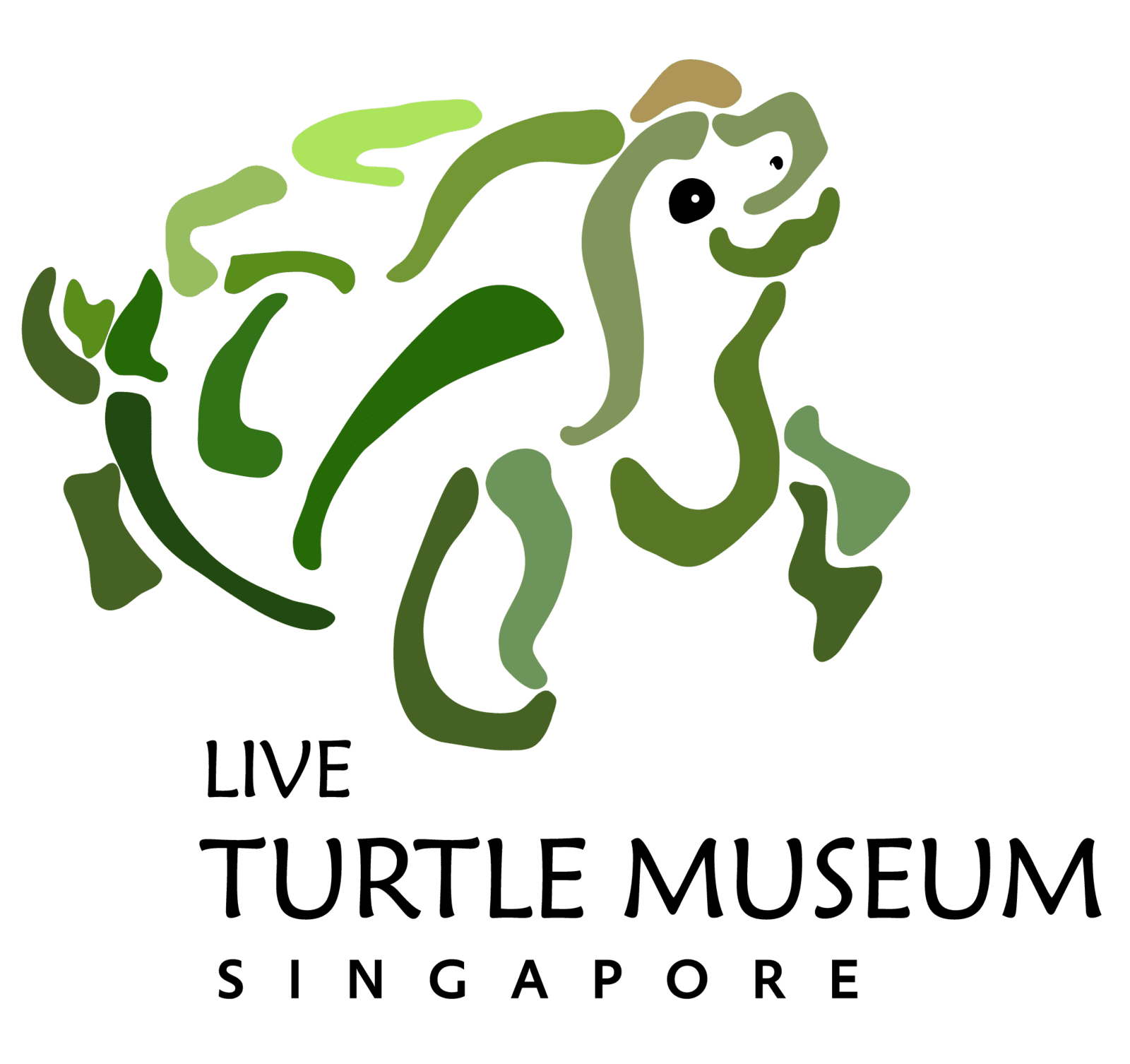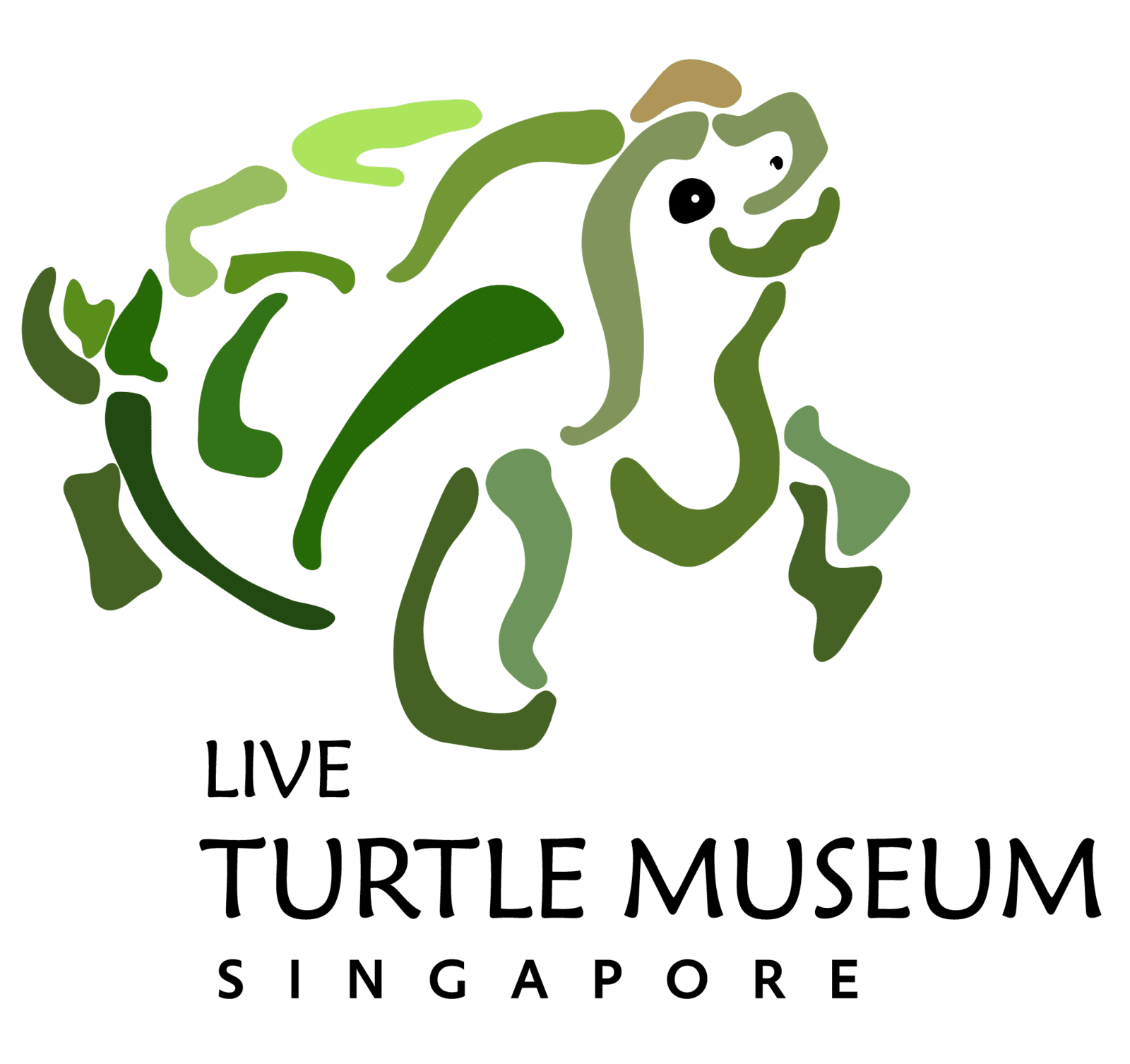Pig-Nose Flying Turtle
(Carettochelys Insculpta)
Pig nose turtles are truly one of a kind among freshwater turtles. Where one would normally find webbed feet, these turtles have adapted flippers to help them traverse gracefully in large bodies of water. Another distinguishing trait is its long & fleshy nostrils which resembles that of a pig’s nose, giving this species of turtle its very apt name.
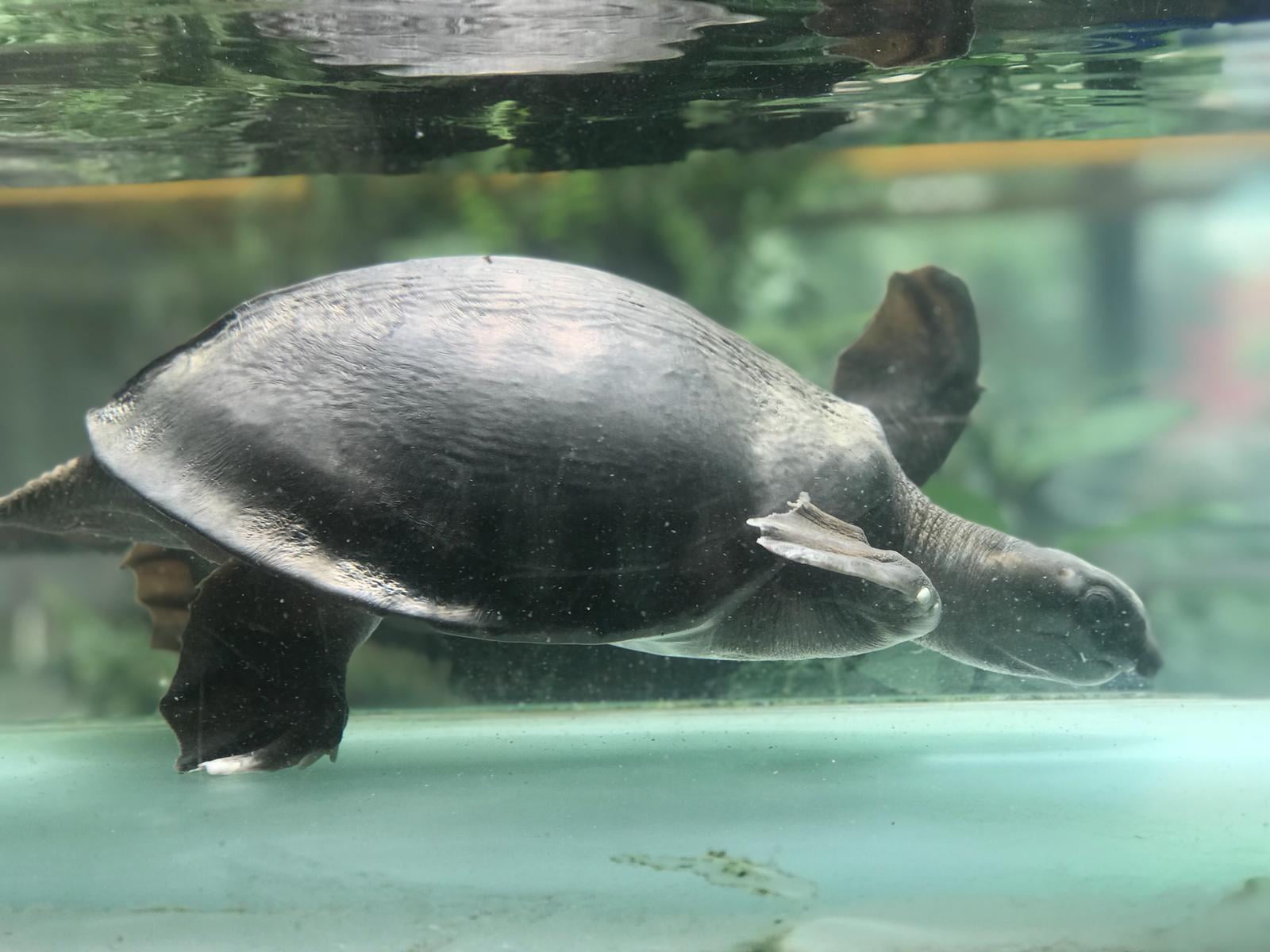
Habitat
They are endemic to Papua New Guinea but can also be found in Northern Australia as well as southern Indonesia. They typically prefer warm bodies of water & have been observed in rivers & lakes. Pig nose turtles are predominantly carnivorous, making use of their strong jaws to crush crustaceans as well as fish.
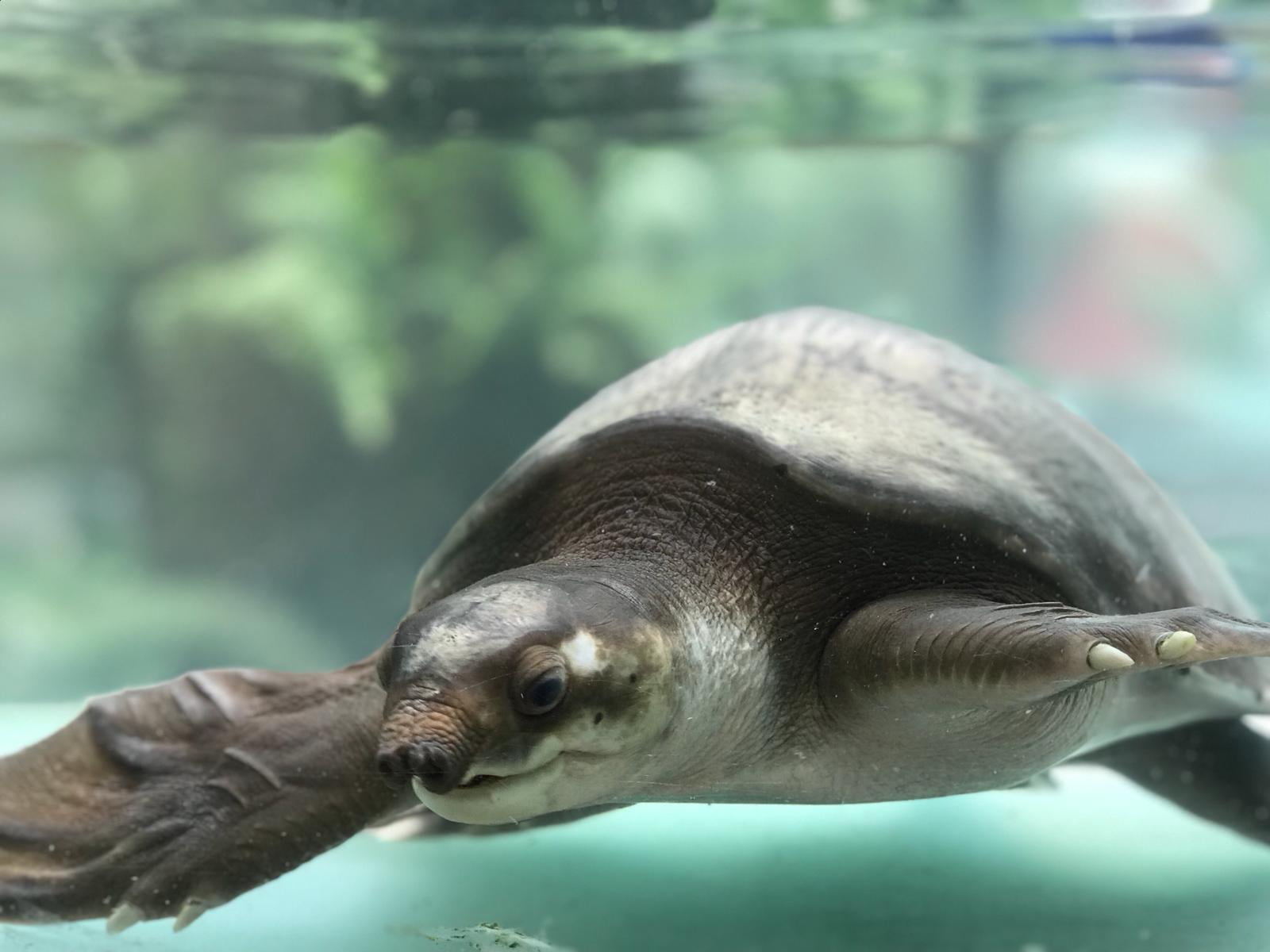
What I do when I'm not in the museum
Their flipper-feet adaptation has made them incredibly powerful swimmers well adapted to escaping from predators in their native environment. Using their muscular forelegs, they are able to propel themselves forward while their tail acts as a rudder, providing them great maneuverability in the presence of danger. They are one of the only reptiles whom eggs hatch underwater!
| Weight Up to 30kg | Lifespan 25-30 years |
| Size up to 70cm | Diet Fish, river grass, and other small aquatic animals |
Alligator Snapping Turtle
(Macrochelys temminckii)
Alligator Snapping Turtles are the dragons of the deep which originate from the south-eastern waters of the United States. It shares its name with the alligator due to the ferocious power in its beaklike jaws as well as its ridged spiky exterior which encompasses its entire carapace. Their dark solid appearance additionally lends itself to being a master of camouflage in the deep murky waters it resides in. It has a unique worm-like appendage in its tongue which draws curious fish looking for a quick meal only to be snapped by the jaws of this prehistoric dinosaur.

Habitat
This turtle spends its time almost exclusively in river bottoms lying in wait for its prey. As the largest freshwater turtle in North America and one of the largest in the world, these snappers have established themselves as the apex predator of their eco systems.
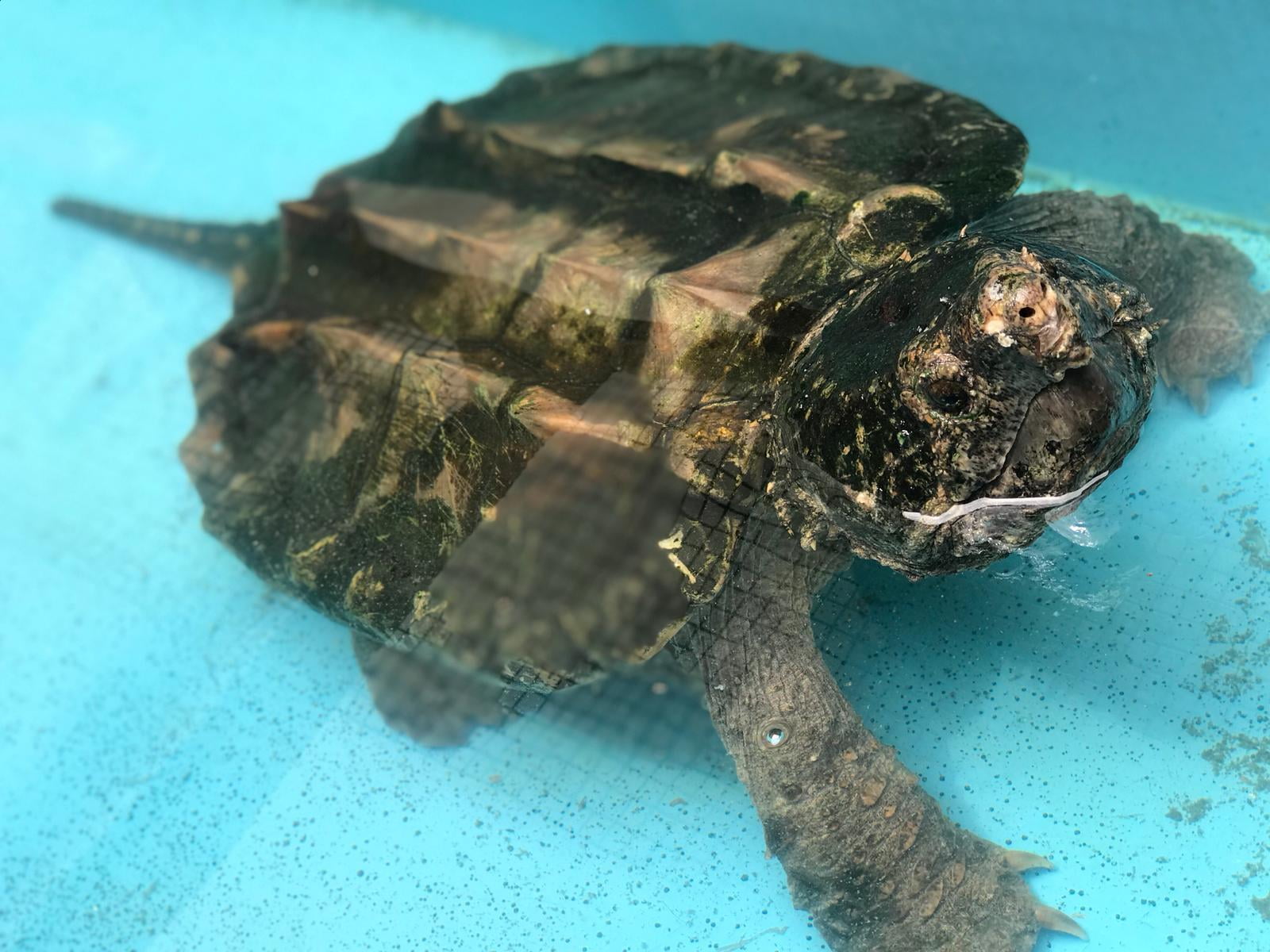
What I do when I'm not in the museum
They are solitary creatures that show little to less parental care. While adult alligator snappers reside in rivers, swamps and canals, the hatchlings stay near small streams. The mating season for Alligator snapping turtles begins in early spring in the southern part of the continent like Florida and late spring in northern ends like Mississippi Valley. The species is a polygynandry species which means both male and female snappers mate with more than one partner.
| Weight Up to 90kg | Lifespan Up to 100 years |
| Size up to 80cm | Diet Fish, and other small aquatic animals |
Common Snapping Turtle
(Chelydra Serpentina)
The American Snapping Turtle or Common Snapping turtle are highly aggressive reptiles most noted for its combative disposition with its razor sharp beak – like jaws which it uses to tear the flesh off its prey in conjunction with its highly mobile serpentine like head. They are native to North America and live in lakes & streams where there are abundant amounts of fish for it to hunt.
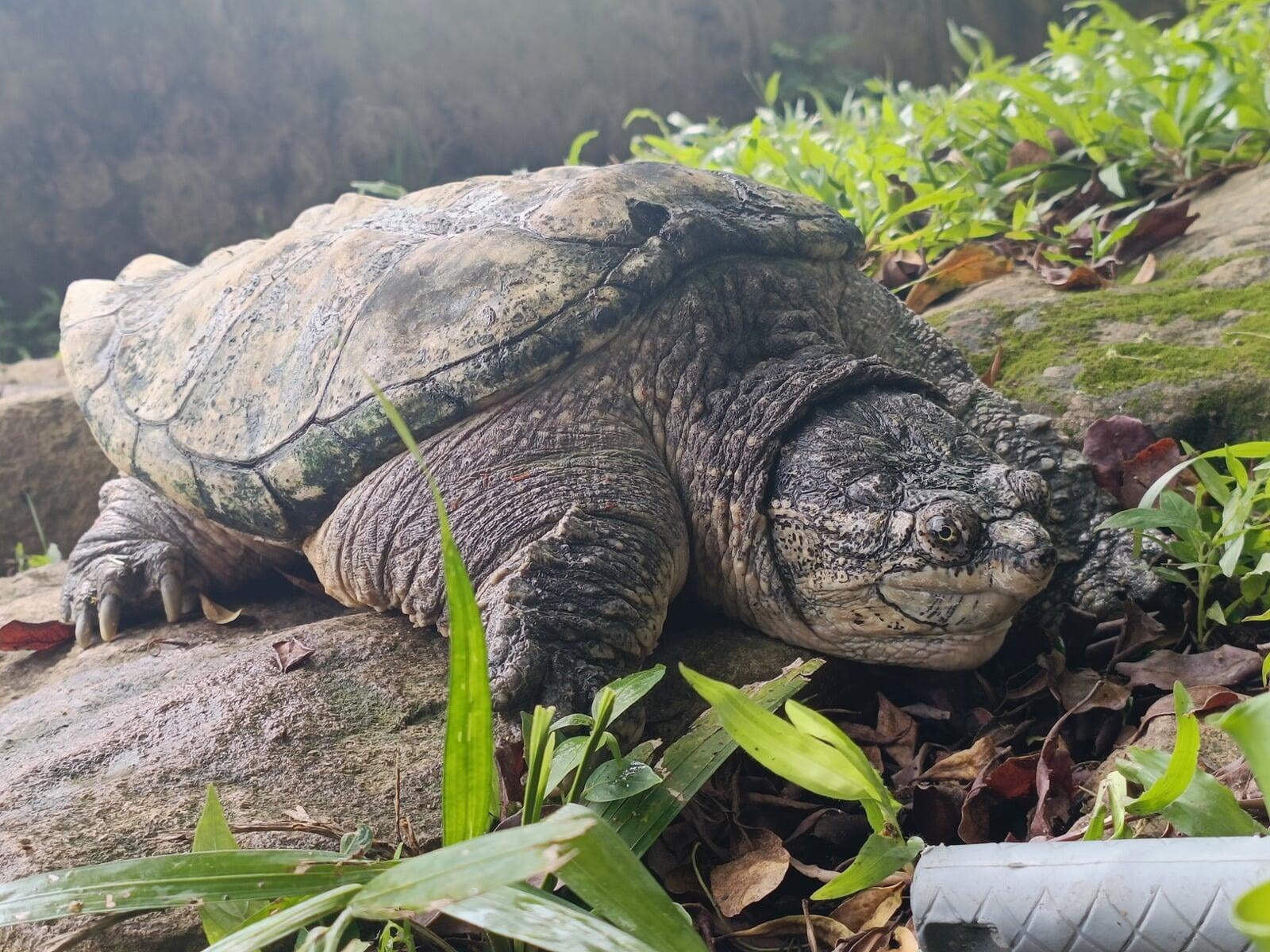
Habitat
These snappers commonly inhabit large bodies of fresh water including lakes & rivers but have also been observed in slow moving water such as small streams or ponds where a muddy riverbed & abundance of aquatic vegetation provide the ideal environment for them to thrive.
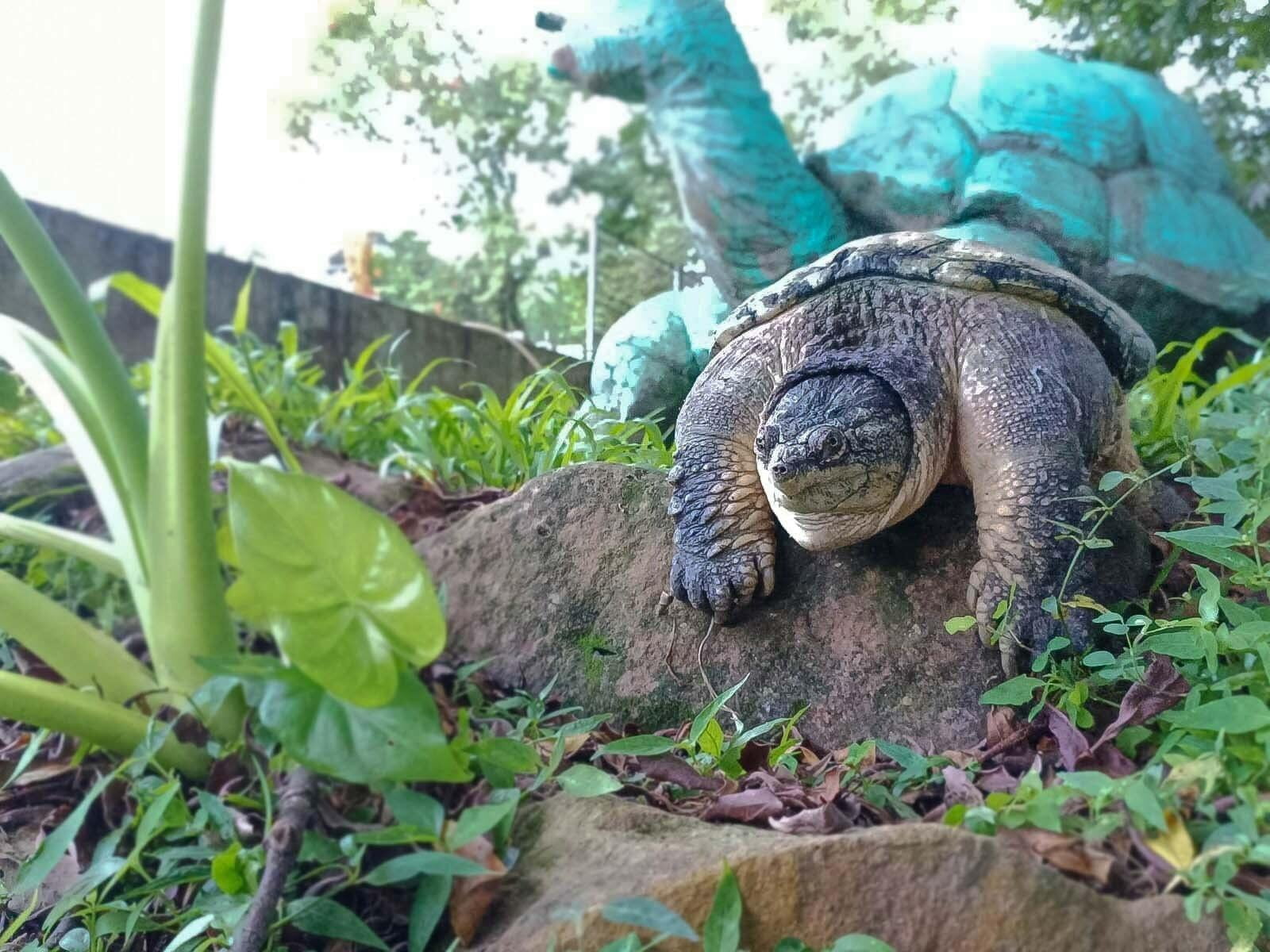
What I do when I'm not in the museum
American snapping turtles are opportunistic feeders that spend most of their time in water feeding on anything unfortunate that crosses its serpentine path, making them usually solitary animals. They are diurnal reptiles who are most active at dawn & dusk, lurking on the dark muddy river beds where they are able to stalk their prey as well as limit themselves to predation from above. When basking, these turtles rarely come onto land to bask but rather float on the water’s surface with merely its snout and carapace exposed in order to soak in the suns ray for its UVB needs.
| Weight Up to 16kg | Lifespan 40-55 years |
| Size 20cm-30cm | Diet Fish, and other small aquatic animals |
Malayan/Asian Box Turtle
(Cuora amboinensis)
Alternatively known as the Amboina box turtle, they are endemic to Southeast Asia. They are distinguished by the yellow lines which run past the side of their faces & the ability to withdraw its limbs & head completely into its box like shell when frightened. They are omnivorous semi-aquatic reptiles who are popular in the exotic pet trade & are one of the only few species of reptiles for sale as pets in Singapore, albeit available rarely.
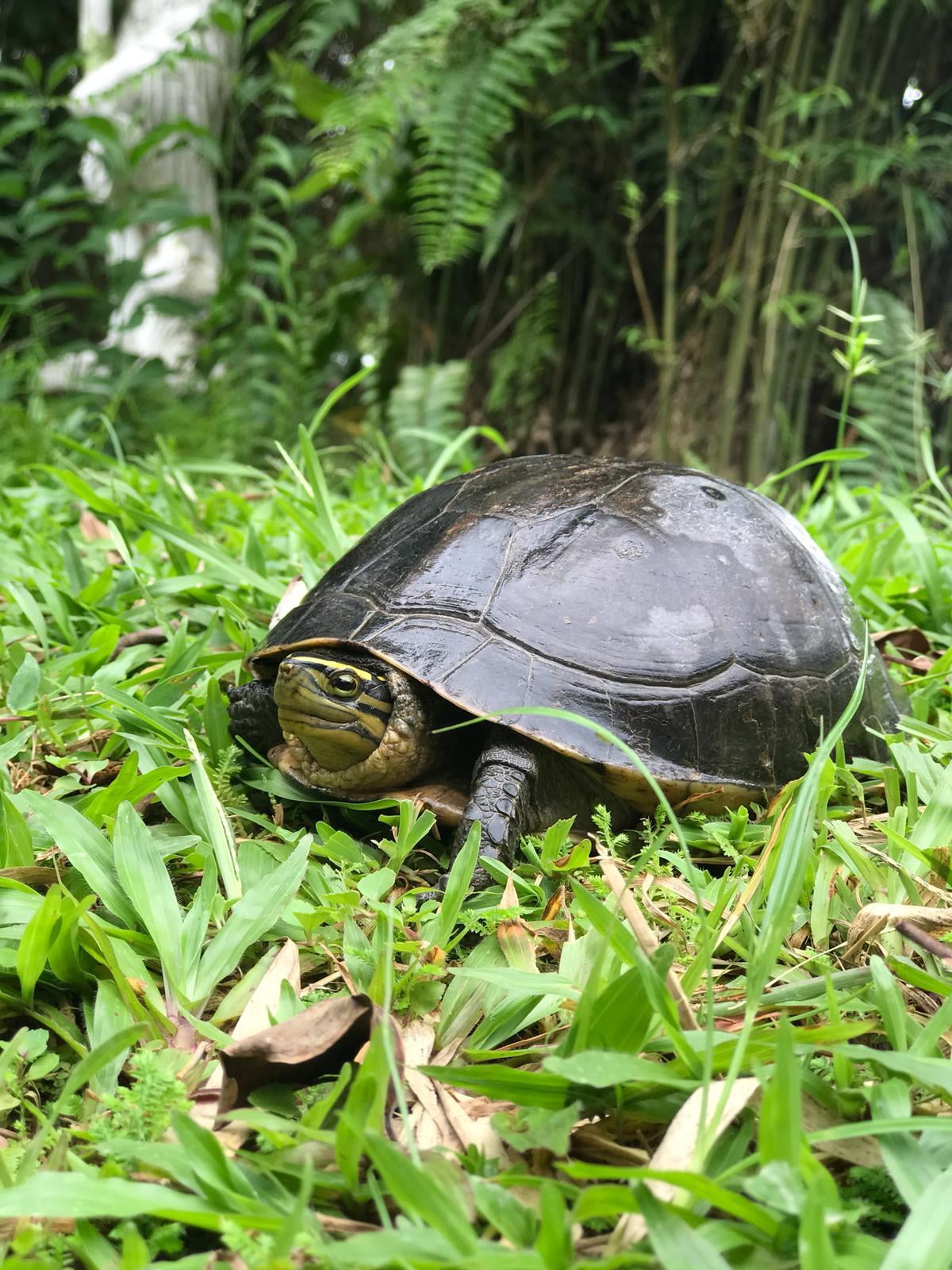
Habitat
They are endemic to a large portion of Asia, predominantly occurring in India, Bhutan, Bangladesh, Myanmar, Thailand, Cambodia, Vietnam, Malaysia, Philippines, Singapore & Indonesia. Preferring warm bodies of water with slow moving currents, these box turtles can be found in areas such as lakes & streams as well as small ponds & swamps but will also traverse land due to their semi-aquatic nature.
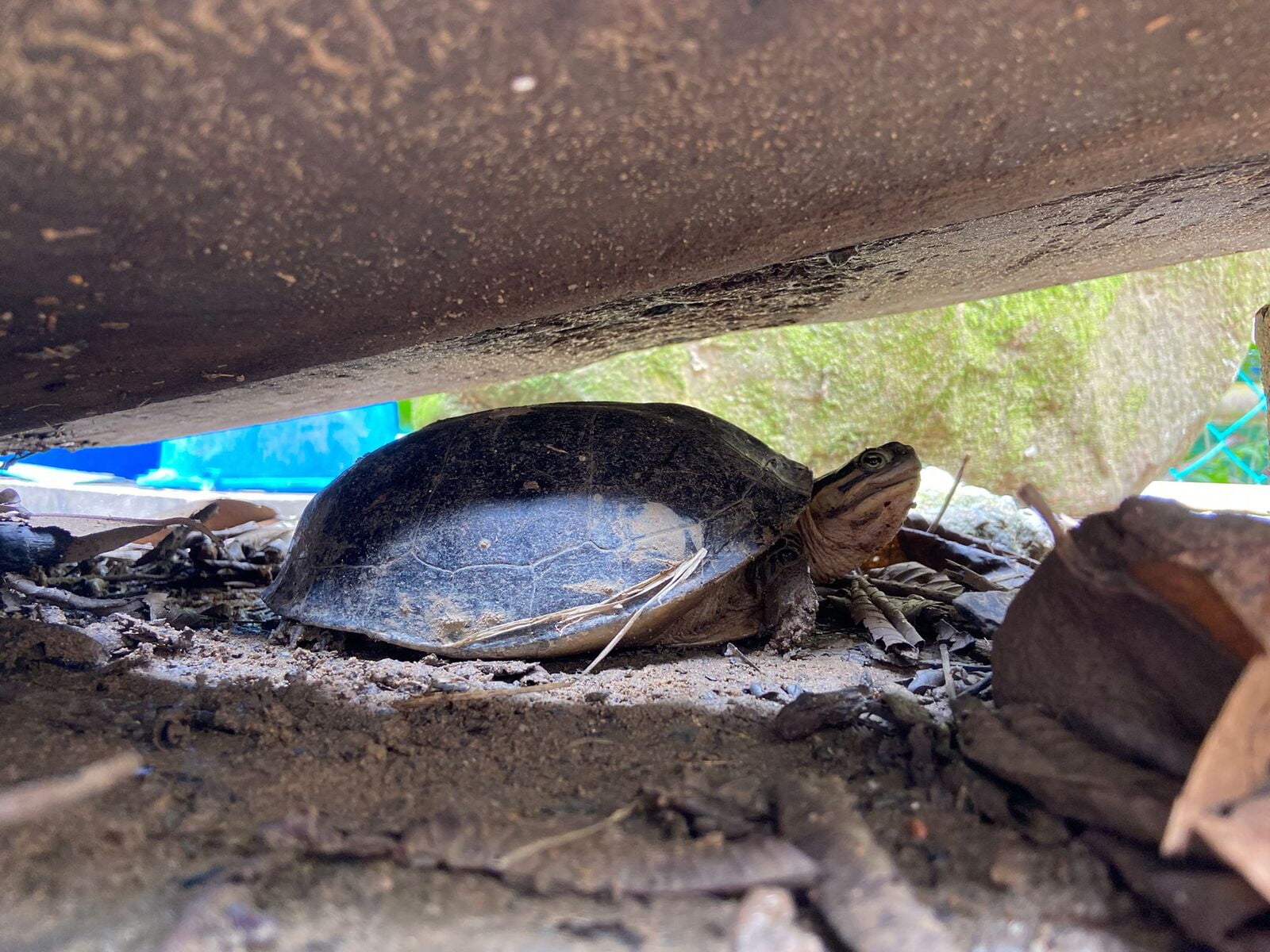
What I do when I'm not in the museum
They are social animals. With the top of its head largely dark green in coloration & a brownish black carapace, these nocturnal turtles are well adapted to hiding in plain sight, taking shelter under the cover of leaves & aquatic vegetation in their environment. While largely aquatic, these turtles will venture on land to forage for food ranging from fallen fruits to worms & insects.
| Weight 1-3kg | Lifespan 25-30 years |
| Size up to 25cm | Diet Fish, river grass, and other small aquatic animals |
Red Ear Slider
(Trachemys Scripta Elegans)
The Red Eared Slider is one of the most common pets in the world. They get their name from the striking red stripe which runs along its ears & its signature ability of being able to effortlessly slide off logs & rocks which they bask on into the water.
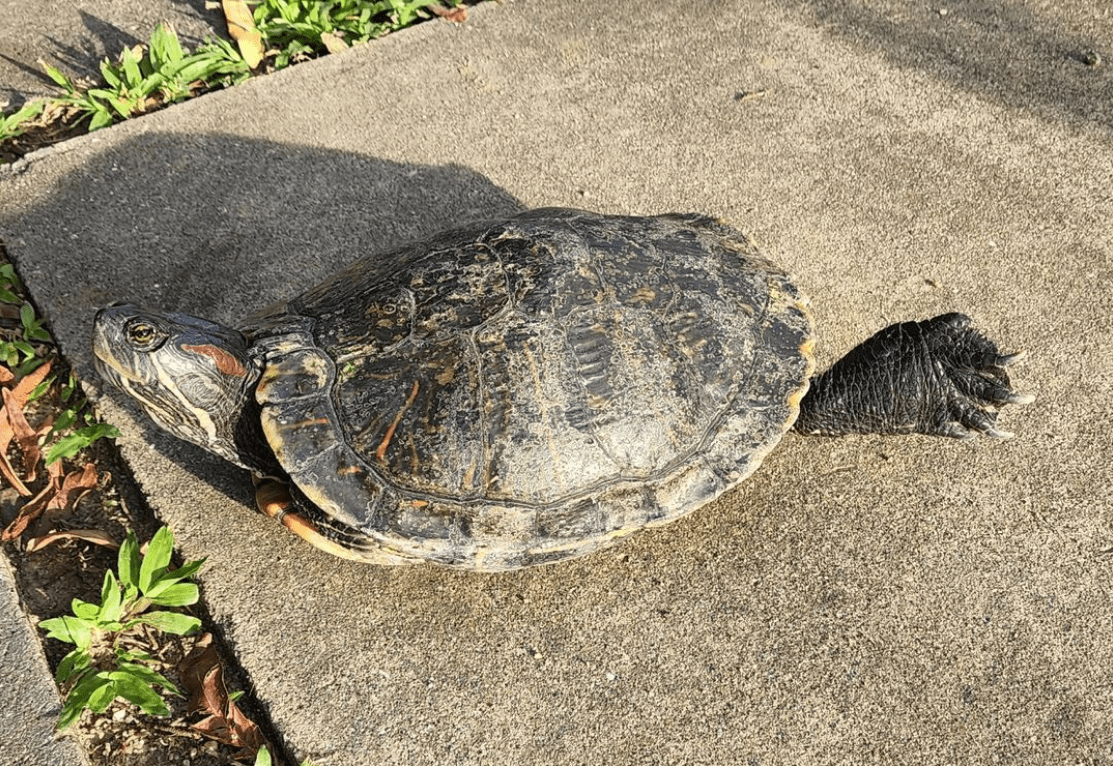
Habitat
The red-eared slider originated from the area around the Mississippi River and the Gulf of Mexico, in warm climates in the southeastern United States. Their native areas range from the southeast of Colorado to Virginia and Florida. They live in areas of calm water where they are able to leave the water easily by climbing onto rocks or tree trunks so they can warm up in the sun.
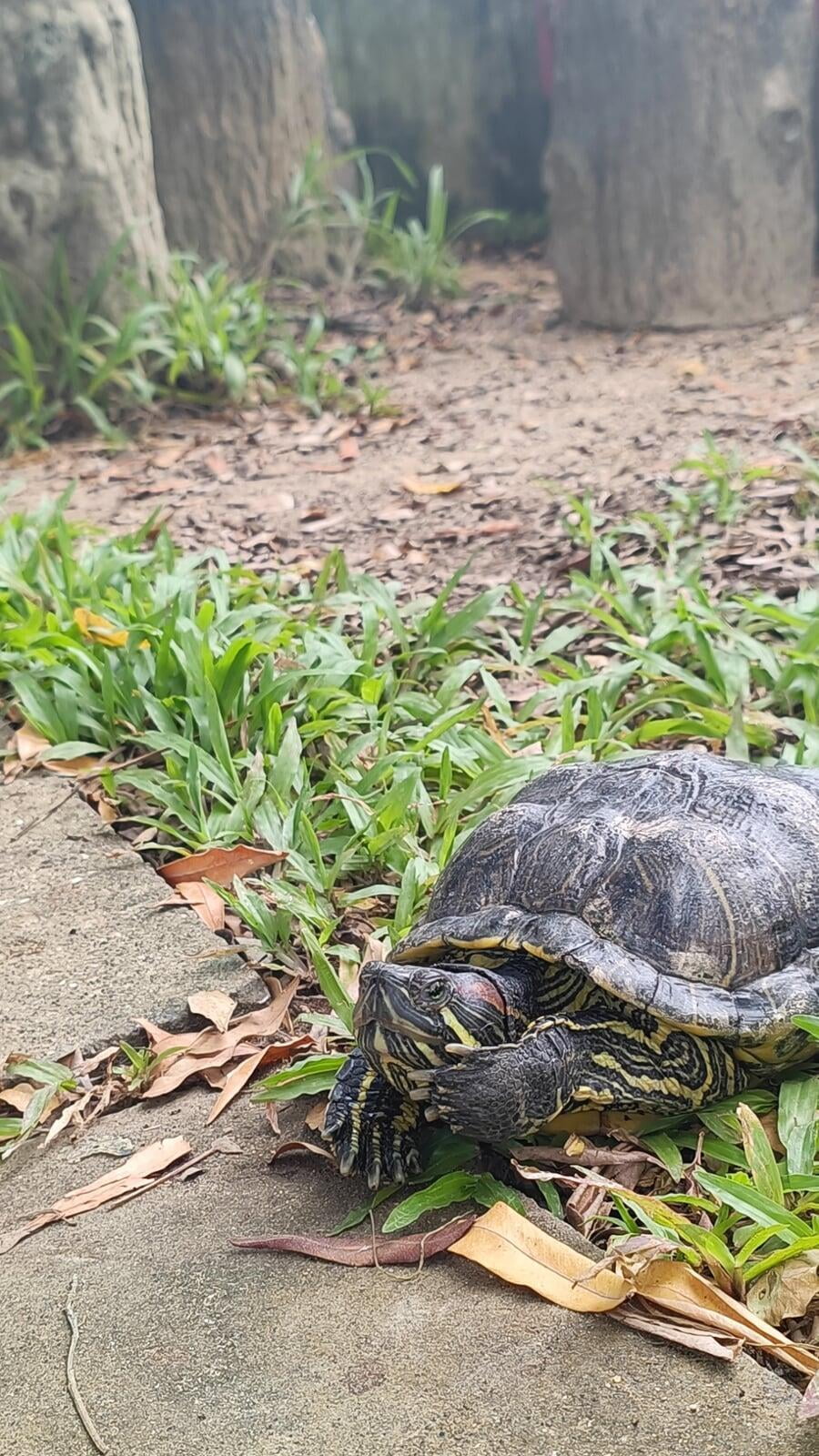
What I do when I'm not in the museum
Individuals are often found sunbathing in a group or even on top of each other. On occasion, a male may appear to be courting another male, and when kept in captivity may also show this behaviour towards other household pets. Between male turtles, it could be a sign of dominance and may preclude a fight. Young turtles may carry out the courtship dance before they reach sexual maturity at five years of age, but they are unable to mate.
| Weight Up to 3kg | Lifespan Up to 30 years |
| Size Up to 30cm | Diet Fish, river grass, and other small aquatic animals |
Asian Soft Shell Turtle
(Amyda Cartilaginea)
Asian Soft – Shell Turtles are a large species of freshwater turtles native to Southeast Asia which inhabit lowland streams deep within forested areas. They have a leathery carapace which is flat & round with a coloration which mimics that of a soft olive green that blends in with the muddy streams in which they inhabit.
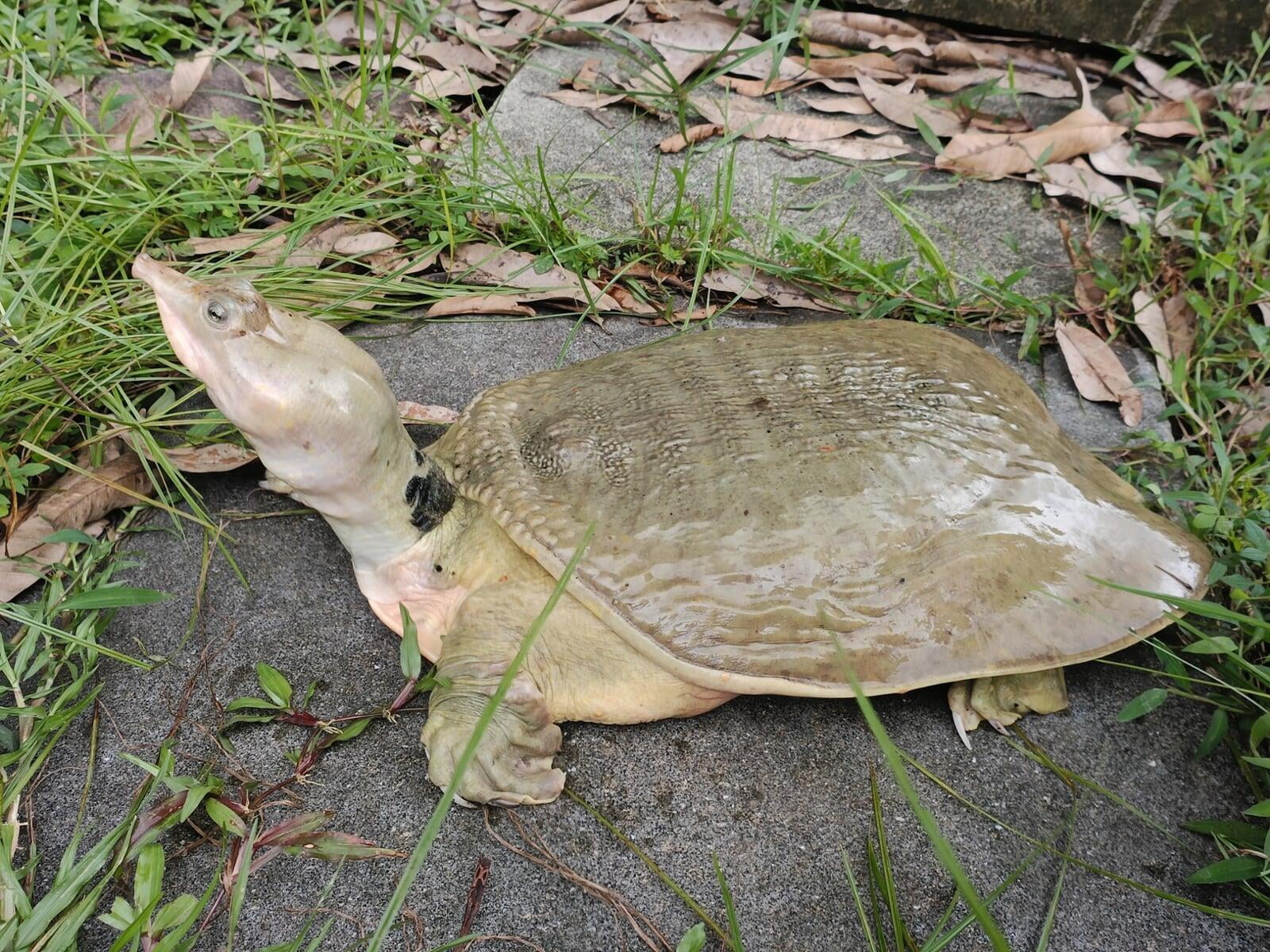
Habitat
These turtles are native to freshwater habitats throughout Southeast Asia including Brunei, Cambodia, India, Laos, Malaysia & Singapore. They commonly will indulge in aquatic vegetation available in their low lying habitats but will not shy away from endemic wildlife including fish & snails which share their environment.
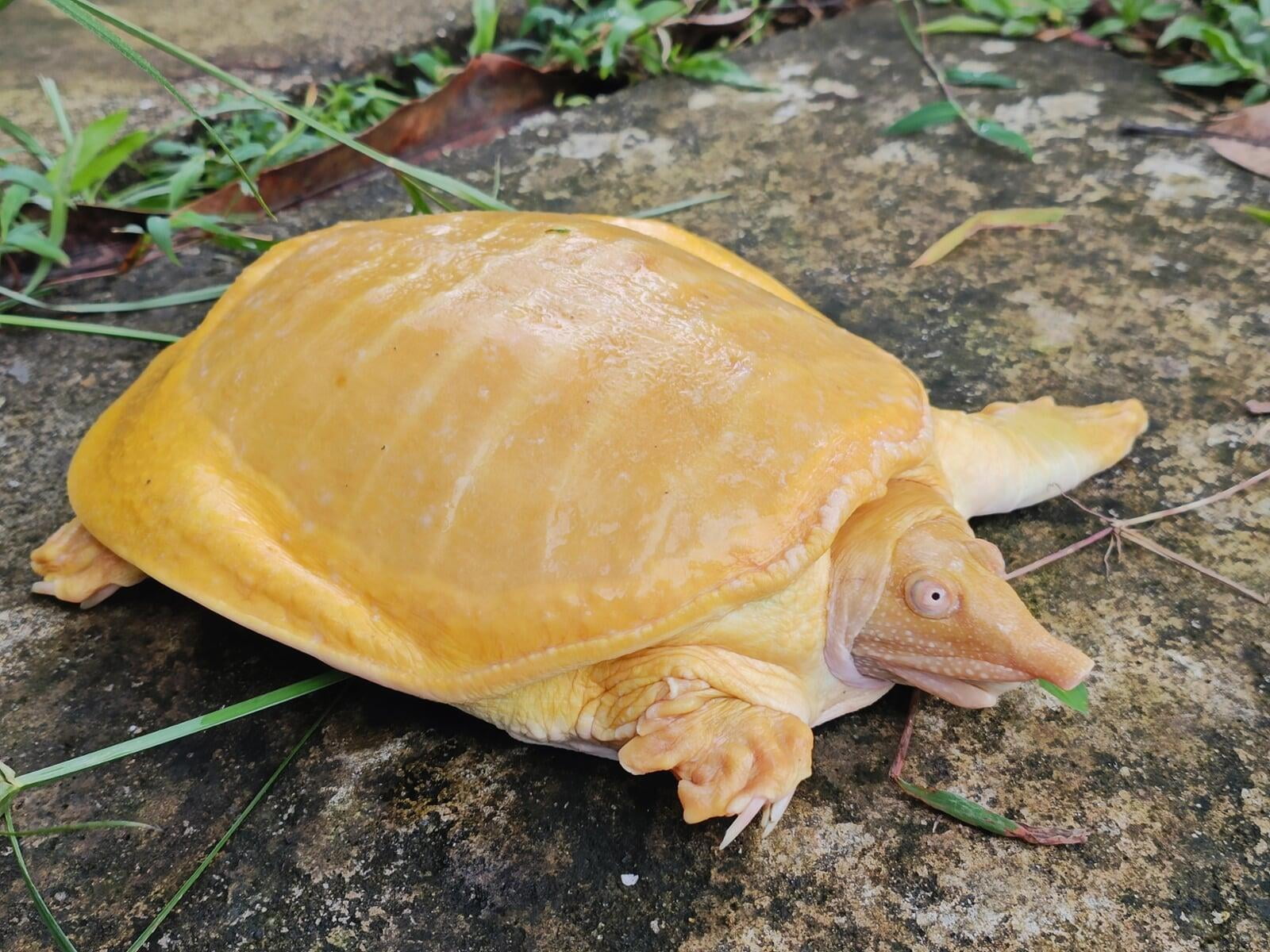
What I do when I'm not in the museum
Asian Soft-Shelled Turtles are rather solitary creatures who tend to stay underwater for long periods by digging into surroundings with their sharp claws and breathing through their skin. This allows them to stay dormant for extended periods of time while stalking unsuspecting prey in their vicinity or protecting themselves from predators.
| Weight Up to 24kg | Lifespan Up to 50 years |
| Size Up to 80cm | Diet Fish, and other small aquatic animals |
Mata Mata Turtle
(Chalus Fimbriatus)
The Mata Mata turtle are large South American freshwater turtles native to the Amazon & Orinoco Basin. Their fascinating appearance is highlighted by its unique physical characteristics such as its triangular flattened head as well as its long & tubular snout.
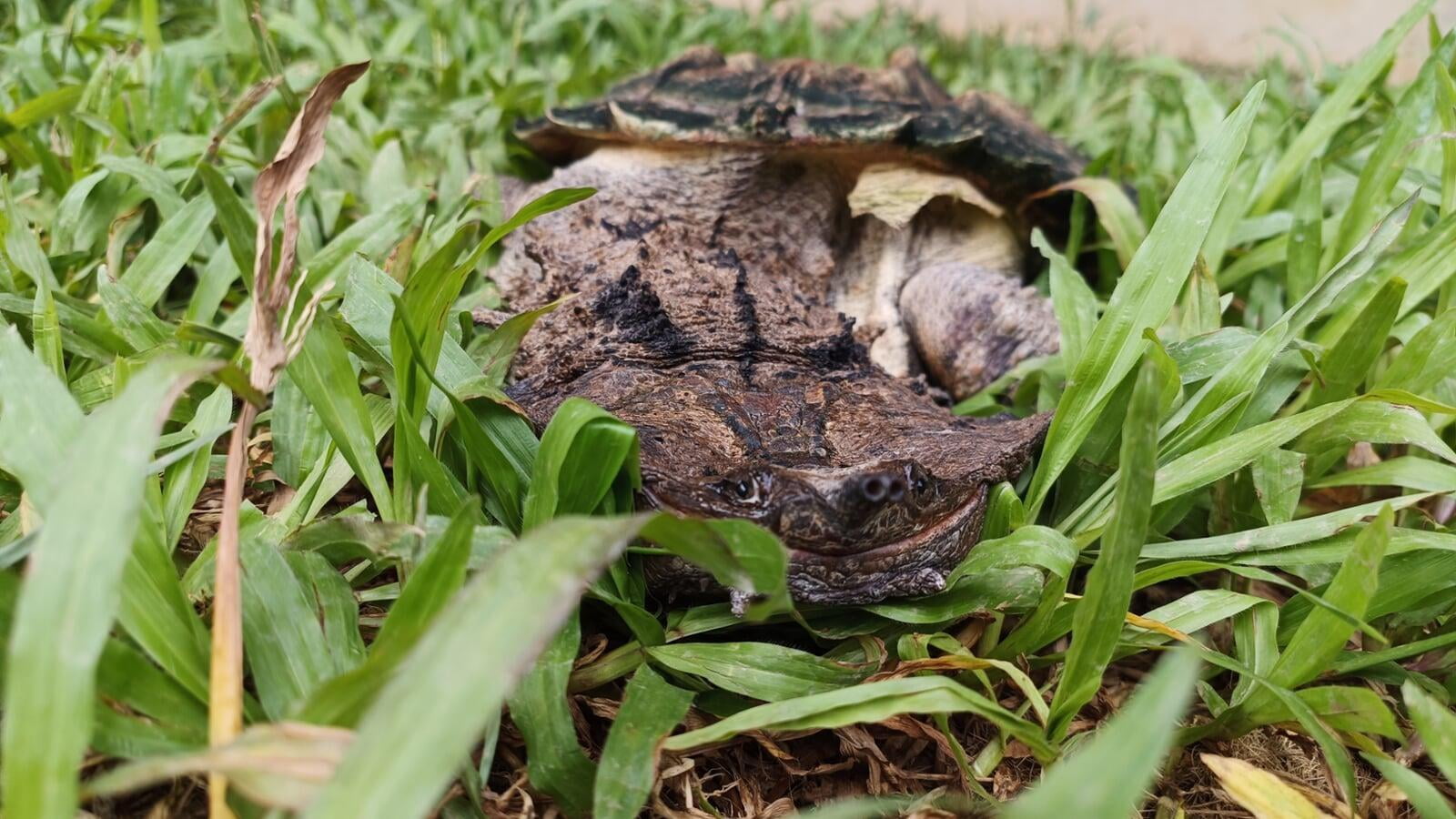
Habitat
They are distributed throughout South America where they live in the shallow areas of low current water locales such as rivers, swamps & marshes. They can be found in the Amazon, Orinoco, & Essequibo river systems of northern South America & have occasionally been spotted in Trinidad & Tobago.
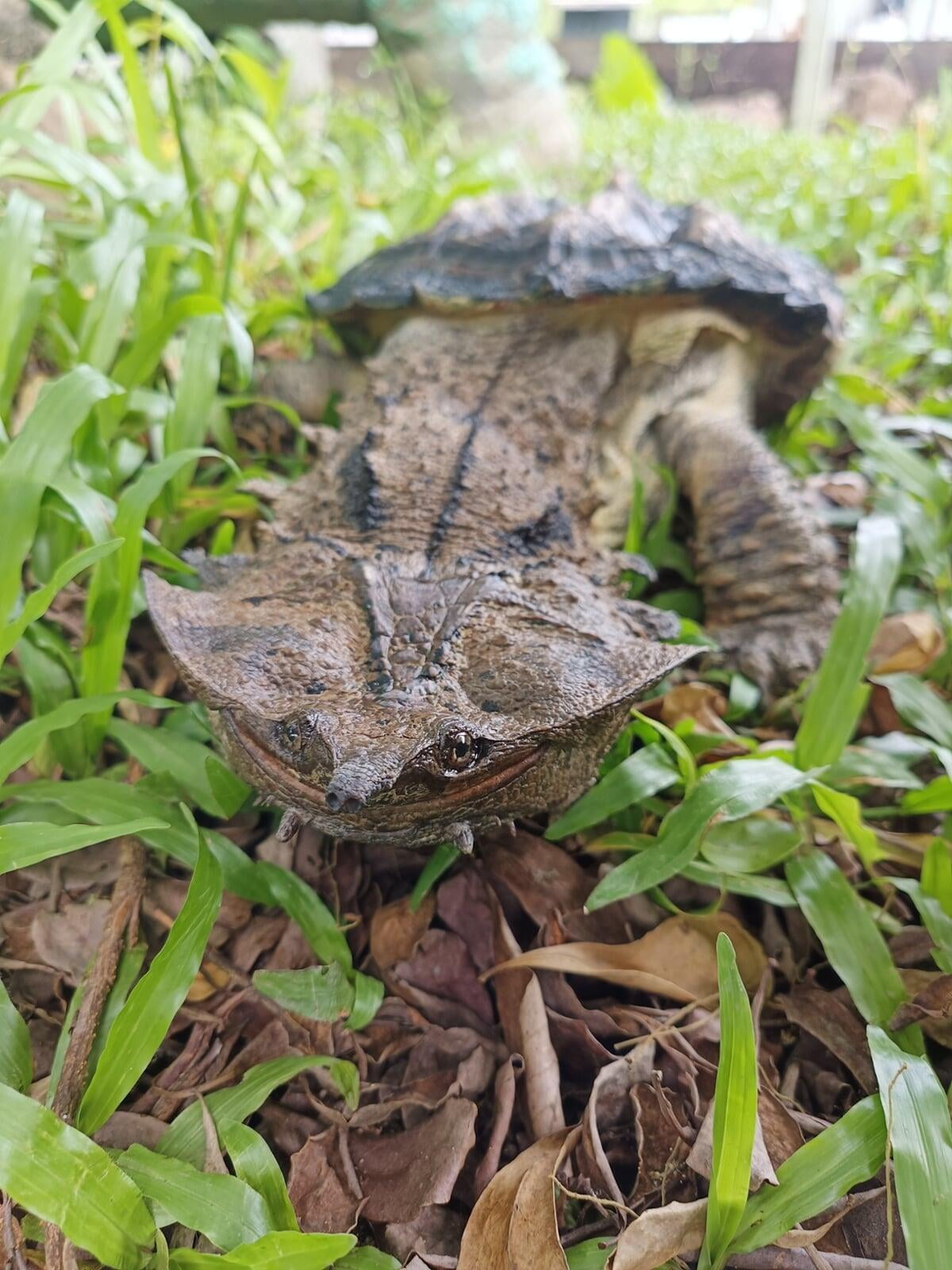
What I do when I'm not in the museum
They are solitary animals, their flattened & dark physical outlook provides them with excellent camouflage which is used to their advantage. Often appearing as large pieces of leaf litter which blend with the murky waters they inhabit, the Mata Mata turtle spend most of their time at the bottom of rivers as opposed to swimming. They are ambush hunters who lie in wait for unsuspecting prey which they suck in akin to a vacuum with the adaptations made to its mouth.
| Weight Up to 20kg | Lifespan 40-75 years |
| Size Up to 50cm | Diet Fish, and other small aquatic animals |
White-Bellied Snapping Turtle
(Elseya branderhorsti)
Also known as the Branderhorst's Snapping Turtle, this turtle is native to the west Papua Indonesia and the western province of Papua New Guinea. They are sometimes confused with other species of snapping turtles native to the same region, but who can blame them when they look so alike! They are excellent swimmers with a sharp jaw and sharp nails to help them to catch fish and other prey easily.
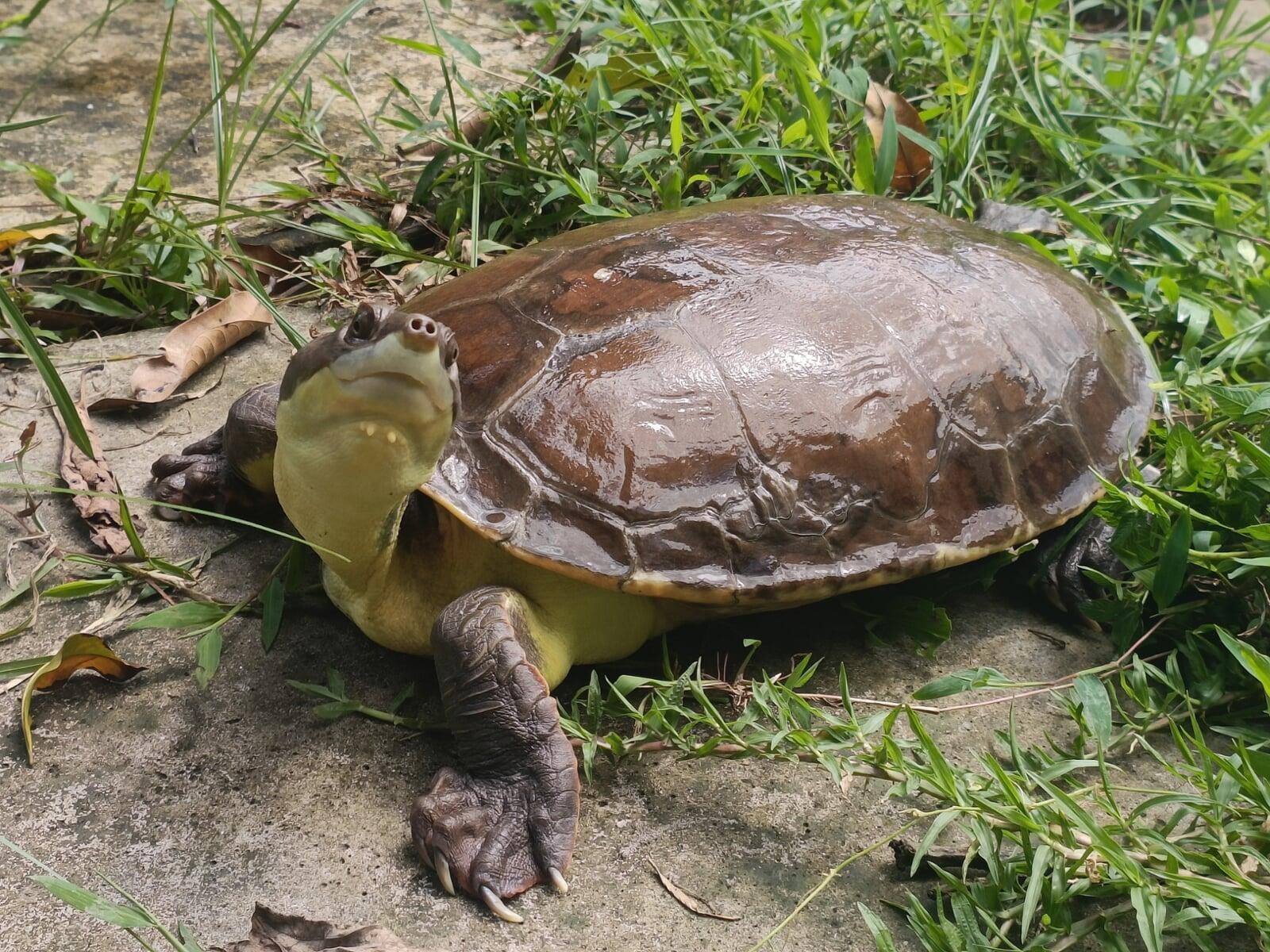
Habitat
They are distributed throughout the rivers in Papua New Guinea and West Indonesia where they live in the shallow areas sometimes they can also be seen in swamps & marshes where food is plentiful.
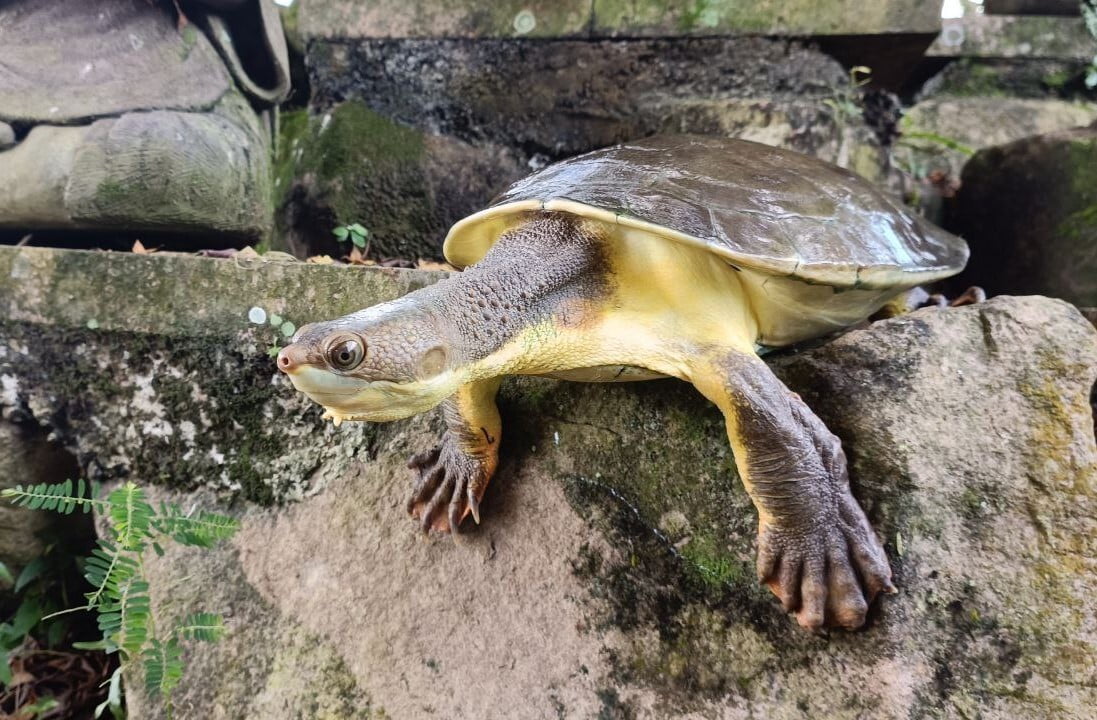
What I do when I'm not in the museum
They are mainly solitary animals that like to swim around and explore their environment on their own. But during mating season, the males are extremely territorial and protective of their mates. They use their sharp claws to scratch and attack and ward off predators and other males. And they are also known to bite any attackers.
| Weight Up to 10kg | Lifespan 20-30 years |
| Size Up to 30cm | Diet Fish, and other small aquatic animals |
Black Marsh Turtle
(Siebenrockiella Crassicollis)
Endemic to Southeast Asia, the Black Marsh Turtle is petite in size when compared to their larger relatives and distinguished by their largely black appearance which envelopes its shell & skin. Alternatively known as the “Smiling Terrapin” due to the nature of its facial structure, this turtle is carnivorous & spends its time foraging in the shallow streams where it hunts.
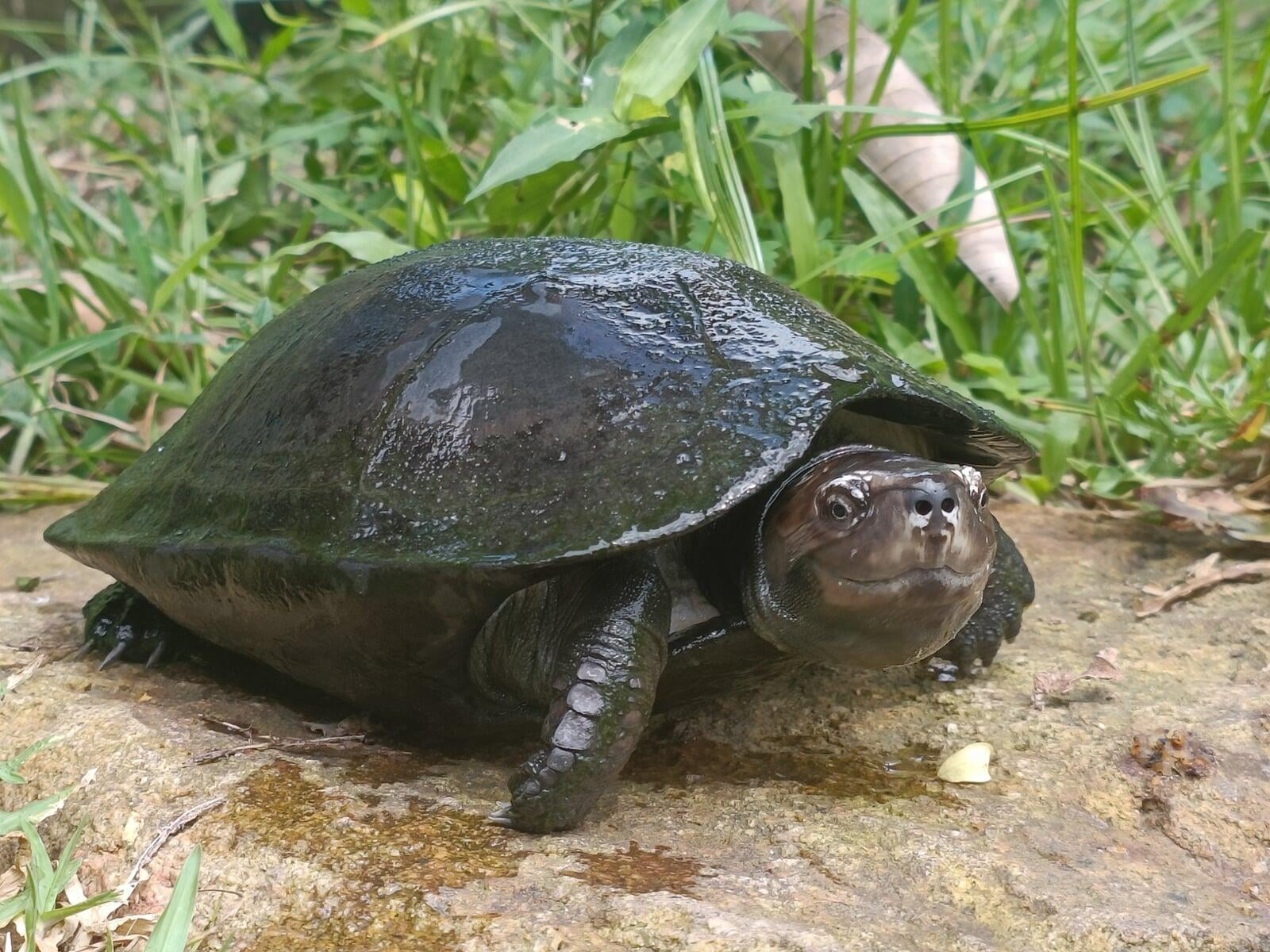
Habitat
These largely aquatic turtles are native to freshwater habitats throughout Southeast Asia including Burma, Thailand, Malaysia & Singapore. They can be found in slow moving or stagnant bodies of water where they typically feast on available wildlife including fish, frogs, snails, worms & carrion.
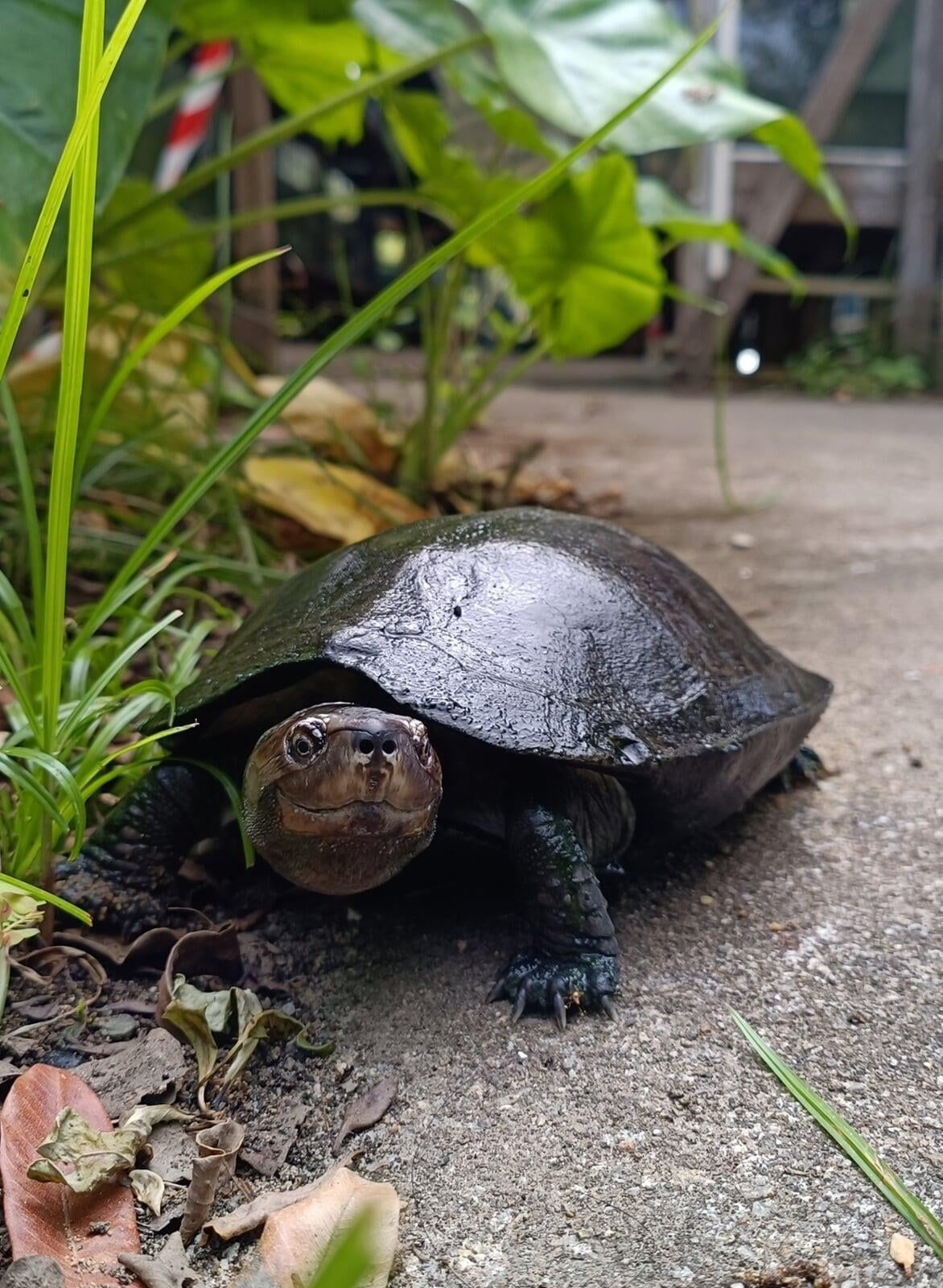
What I do when I'm not in the museum
Black marsh turtles are primarily solitary nocturnal creatures that shy away from the first signs of danger. Timid & weary, they are able to secrete a foul smelling musk from their cloaca which wards off potential predators in their environment. Most of the food is caught and ingested also underwater, although at night it can venture into land to feed or mate.
| Weight Up to 2kg | Lifespan Up to 20 years |
| Size Up to 20cm | Diet Fish, Carrion, and other small aquatic animals |
Yellow-Spotted River Turtle
(Podocnemis Unifilis)
A South American species characterized by the radiant yellow spots it adorns on its head, the Yellow Spotted Amazon turtle is one of the largest South American river turtles. The yellow spots are most prominent in juvenile specimens, with females eventually losing the distinct markings as they age. Males on the other hand retain these spots long into adulthood.
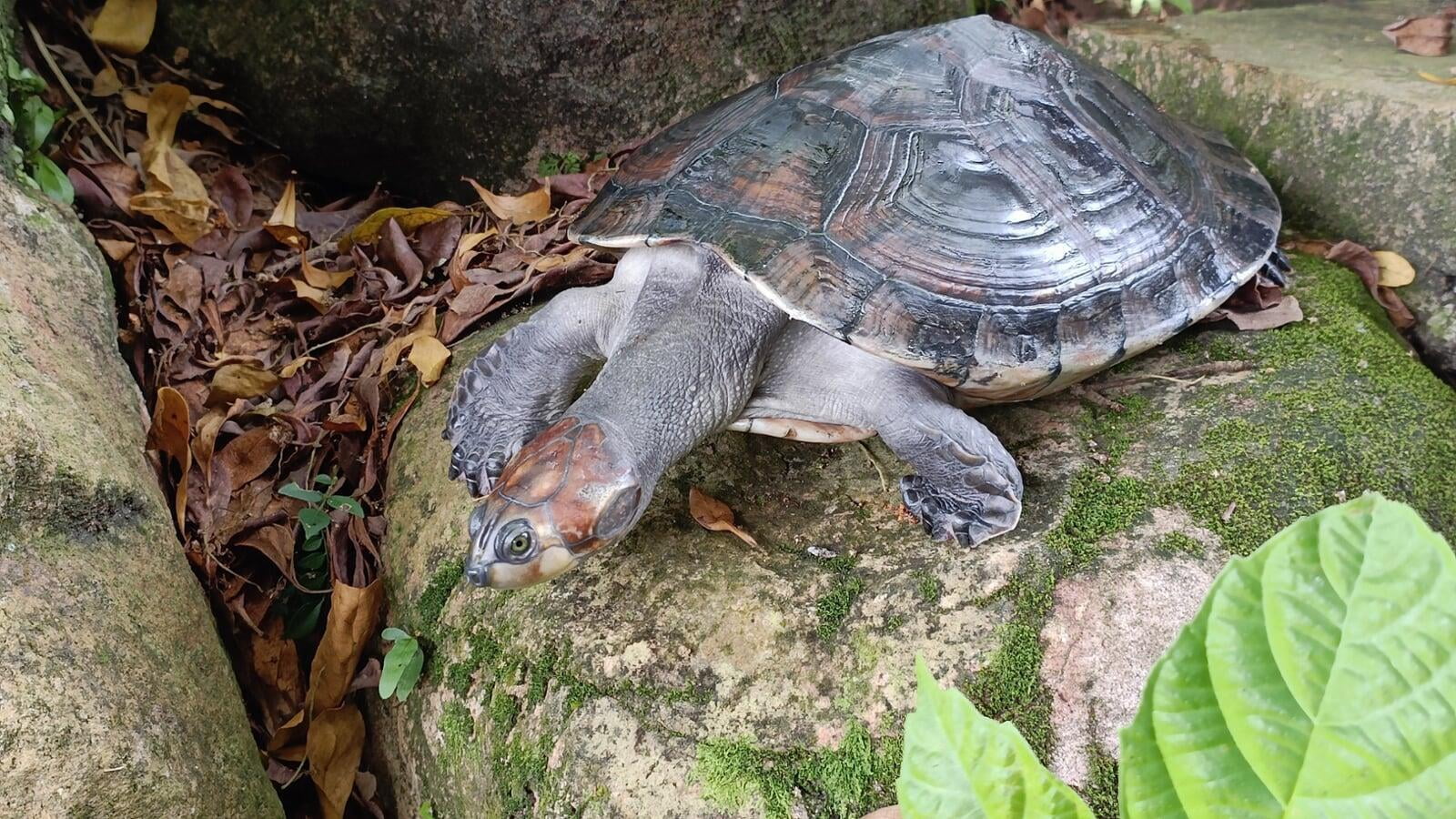
Habitat
Native to the Amazon River basin of South America, Yellow spotted River turtles are predominantly found throughout tributaries & lakes with slow moving current. Their range spreads from the Amazon & Orinoco river systems in Venezuela, eastern Colombia, eastern Ecuador, north-eastern Peru, Brazil & northern Bolivia.
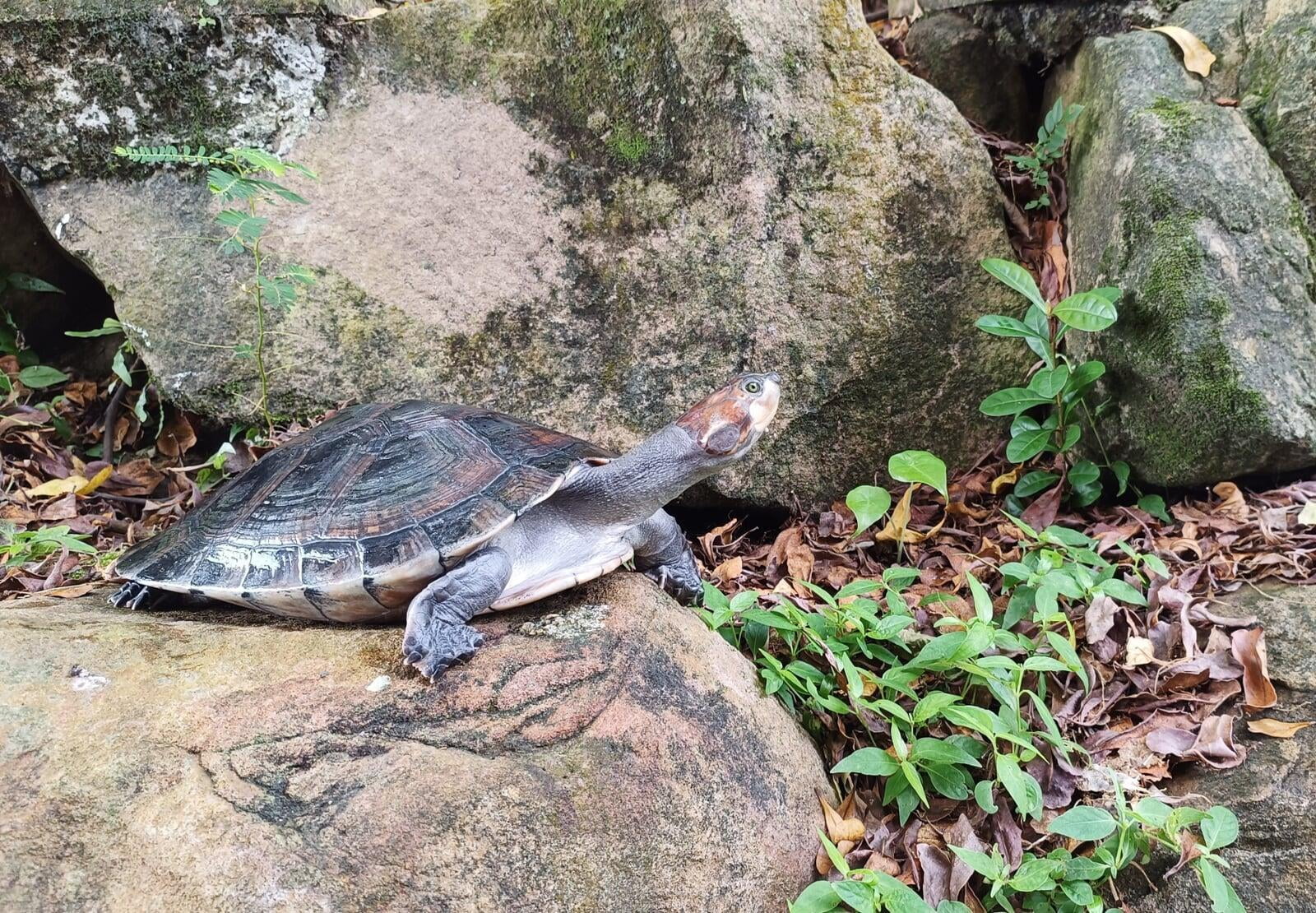
What I do when I'm not in the museum
They prefer to be alone. Males will chase females extensively during the breeding season, nibbling at their feet & tail in an attempt to court them. A diurnal species, these reptiles typically bask in the early mornings & forage for food in the early part of the afternoons. When basking, they are typically observed along the calm waters of lakes and streams where the current is not too strong.
| Weight Up to 8kg | Lifespan Up to 30 years |
| Size Up to 70cm | Diet Fish, river grass, and other small aquatic animals |
Painted Turtle
(Chrysemys Picta)
The Painted Turtle is indigenous to North America, and is also the most widespread native turtle in the region. They are also part of the Chrysemys family of turtles, which makes them very close relatives to the Red Ear Slider. They are very common pets in North America, and because they can adapt to human environments, they have also survived the loss of their natural habitats in some areas and have adapted to live amongst humans.
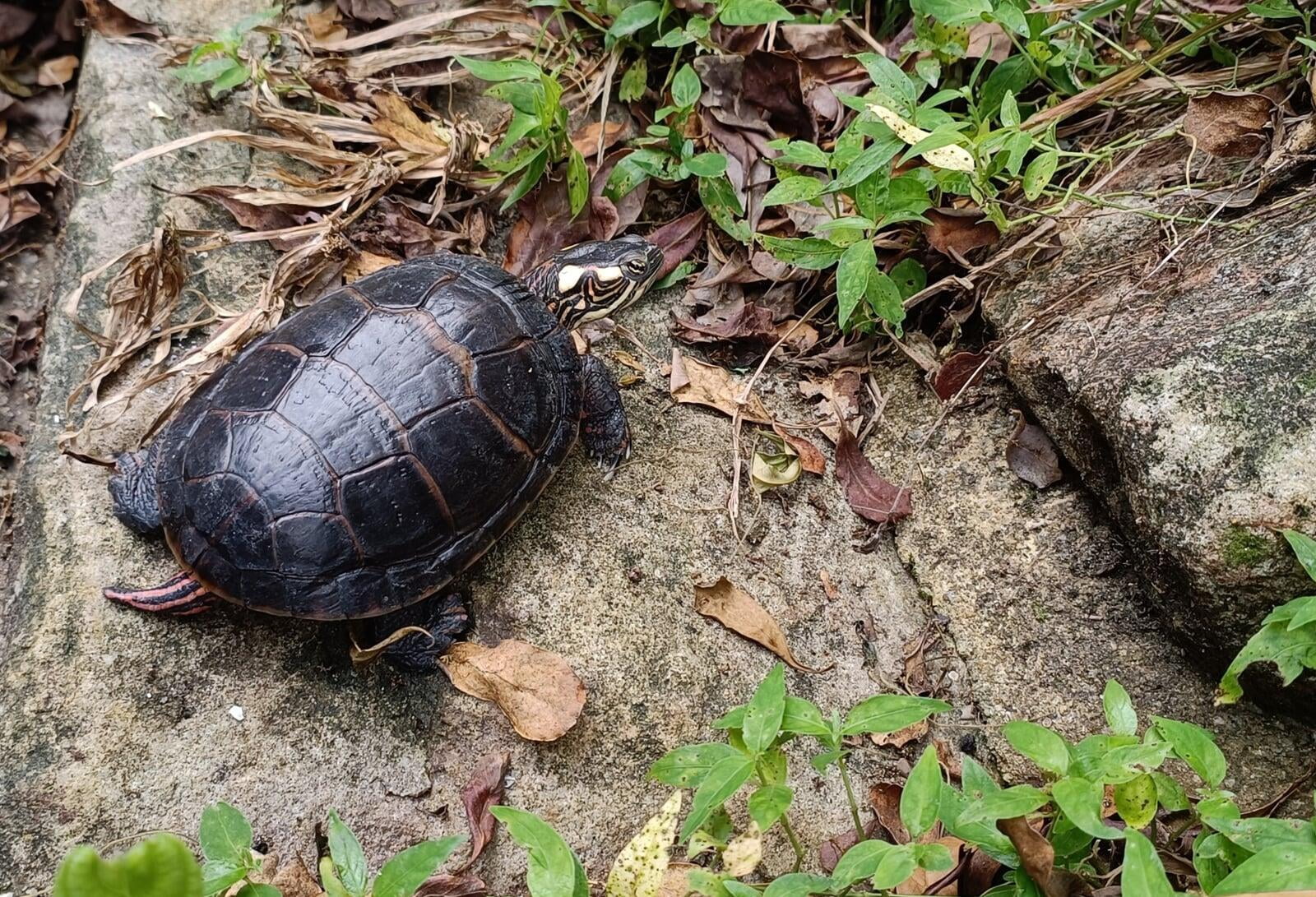
Habitat
Native to the slow moving fresh water bodies stretching from southern Canada to Northern Mexico, as cold blooded animals, they aren't able to make their own body heat, but this species evolved to developed a natural "antifreeze-like" substance in their blood that keeps them from freezing in the colder temperatures up north during winter.
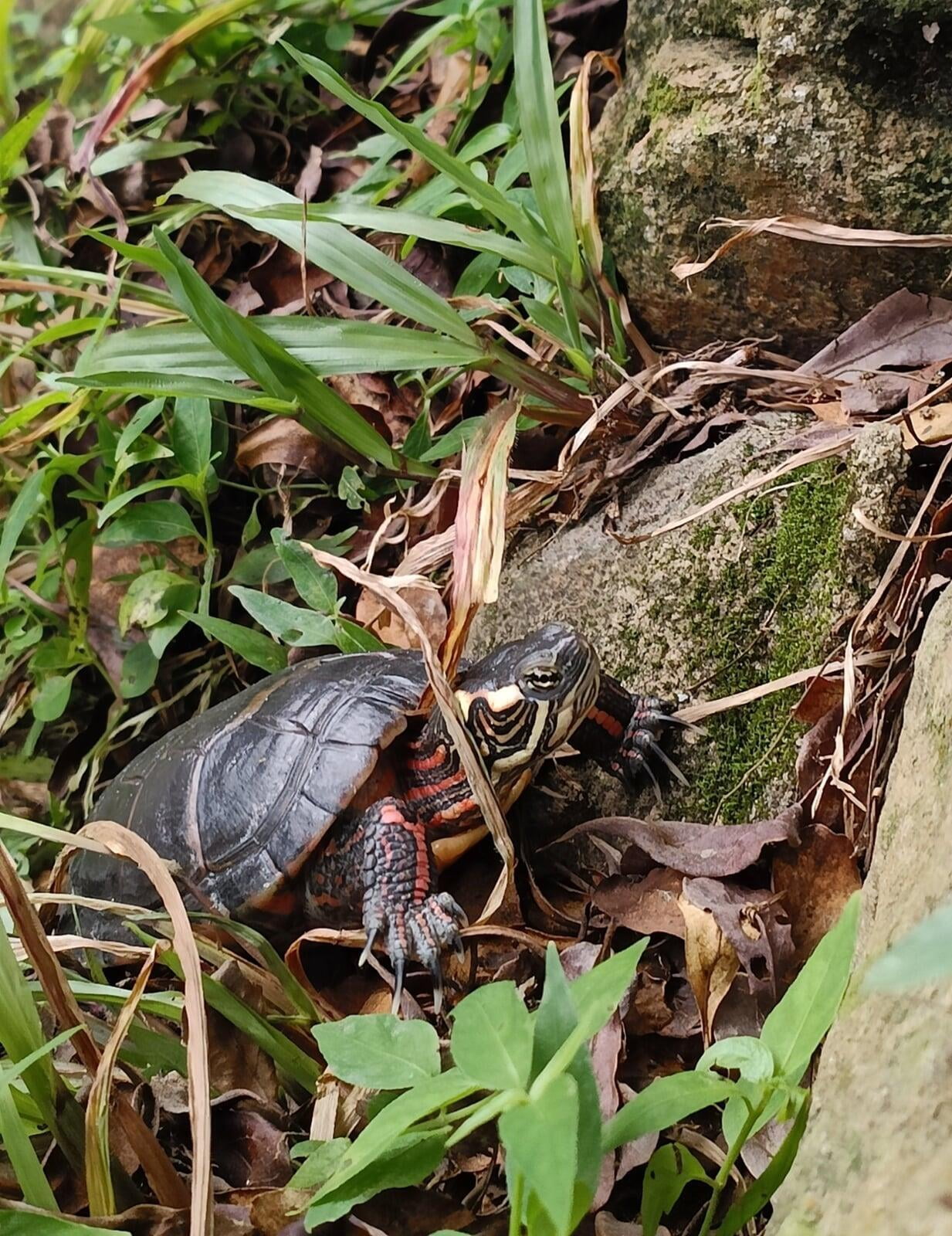
What I do when I'm not in the museum
Similar to the Red Ear Slider and other pond turtles, the painted turtle likes to spend most of its time basking during the day, and socialising with other painted turtles. When finding a mate, the males also go in front of the female, and strokes the female with its longer front claws until an accepting gesture is returned by the female and they begin to mate.
| Weight Up to 1kg | Lifespan Up to 55 years |
| Size Up to 25cm | Diet Fish, river grass, and other small aquatic animals |
Pink Bellied Side-Necked Turtle
(Emydura subglobosa)
This turtle, or also known as the Red-Bellied Short-Necked Turtle, is a unique one. They are indigenous to Australia and New Guinea, and they got the name side-necked turtle because they are actually incapable of retracting their necks like most turtles do. They can only "fold" them to the side, to protect their heads and necks under their shell.
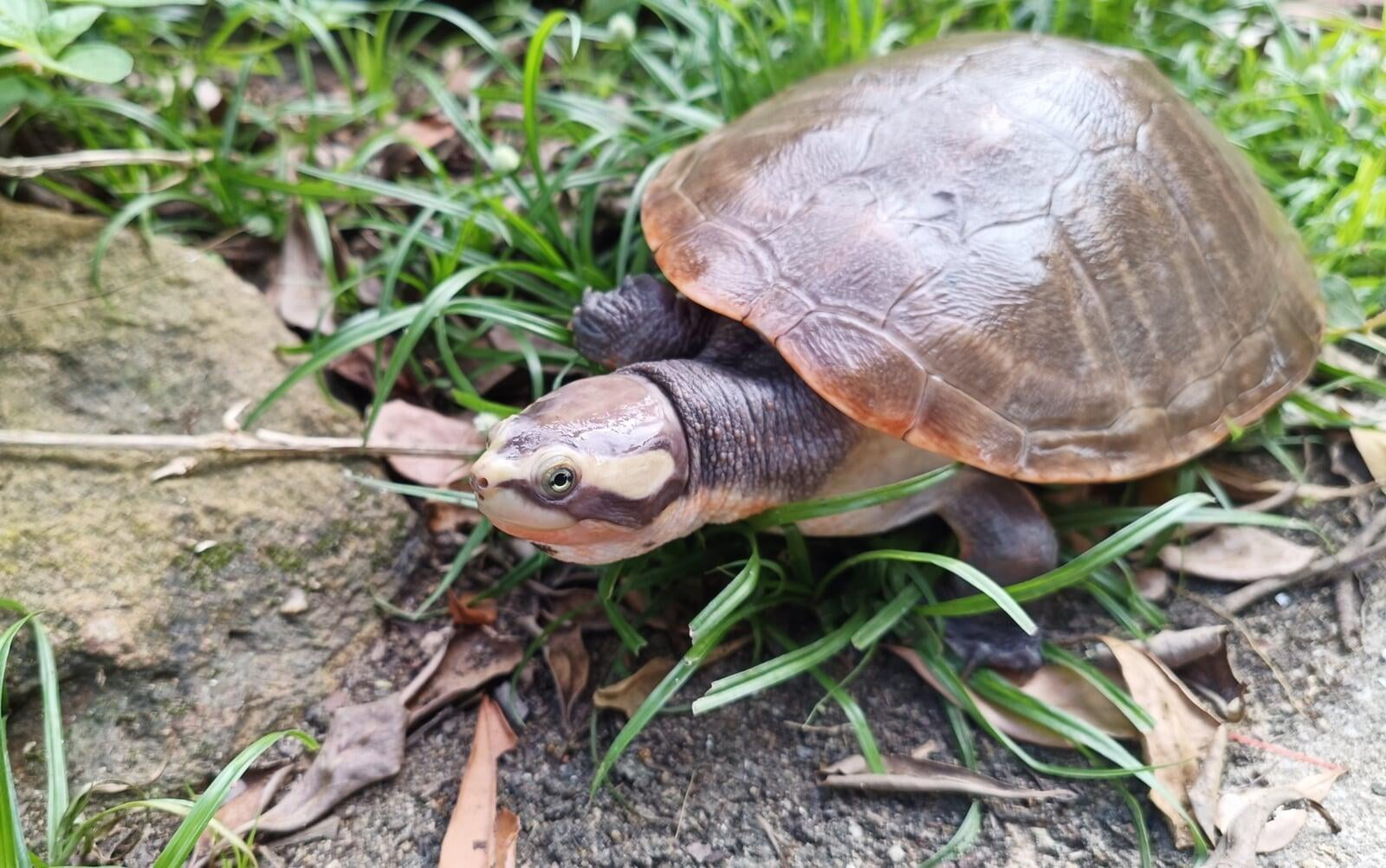
Habitat
These largely aquatic turtles and can be found in freshwater habitats such as rivers, swamps, and sometimes lagoons and lakes. These environment have an abundance of available wildlife including fish, frogs, snails, worms, and river grass which they feed on.
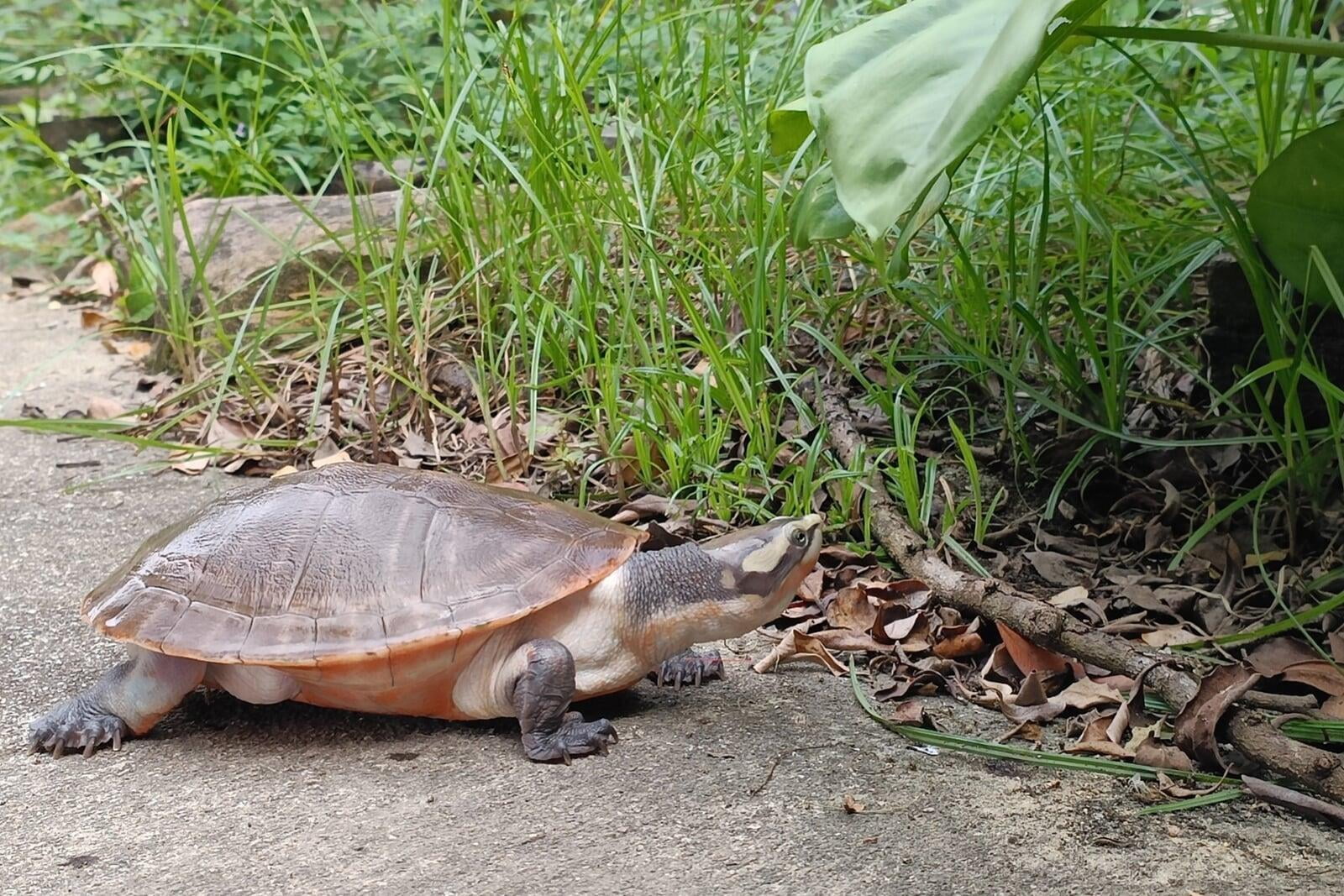
What I do when I'm not in the museum
They are generally shy turtles and prefer the comfort and protection that the water provides. They are very quick and elegant swimmers that make them perfectly suited in their environments. Their shy nature usually means that they are also docile but curious, and is usually a regular option for pets in the regions that they are indigenous to. However, some countries do ban their ownership and export, including Singapore, so they are rare to come by.
| Weight Up to 2.5kg | Lifespan Up to 30 years |
| Size Up to 30cm | Diet Fish, river grass, and other small aquatic animals |
Indian Flapshell Turtle
(Lissemys punctata)
An aquatic turtle dwelling within freshwater bodies in South Asia, this turtle got its name from the shape and folding/flap characteristics of its plastron. It is able to close the plastron after retracting its limbs into its body. This is similar to the box turtles, which are also able to close up its plastron to protect itself. Scientists are still arguing over what protection this offers to the turtle though, because as a soft shelled turtle, closing its plastron might not provide as much protection as those of the box turtles.
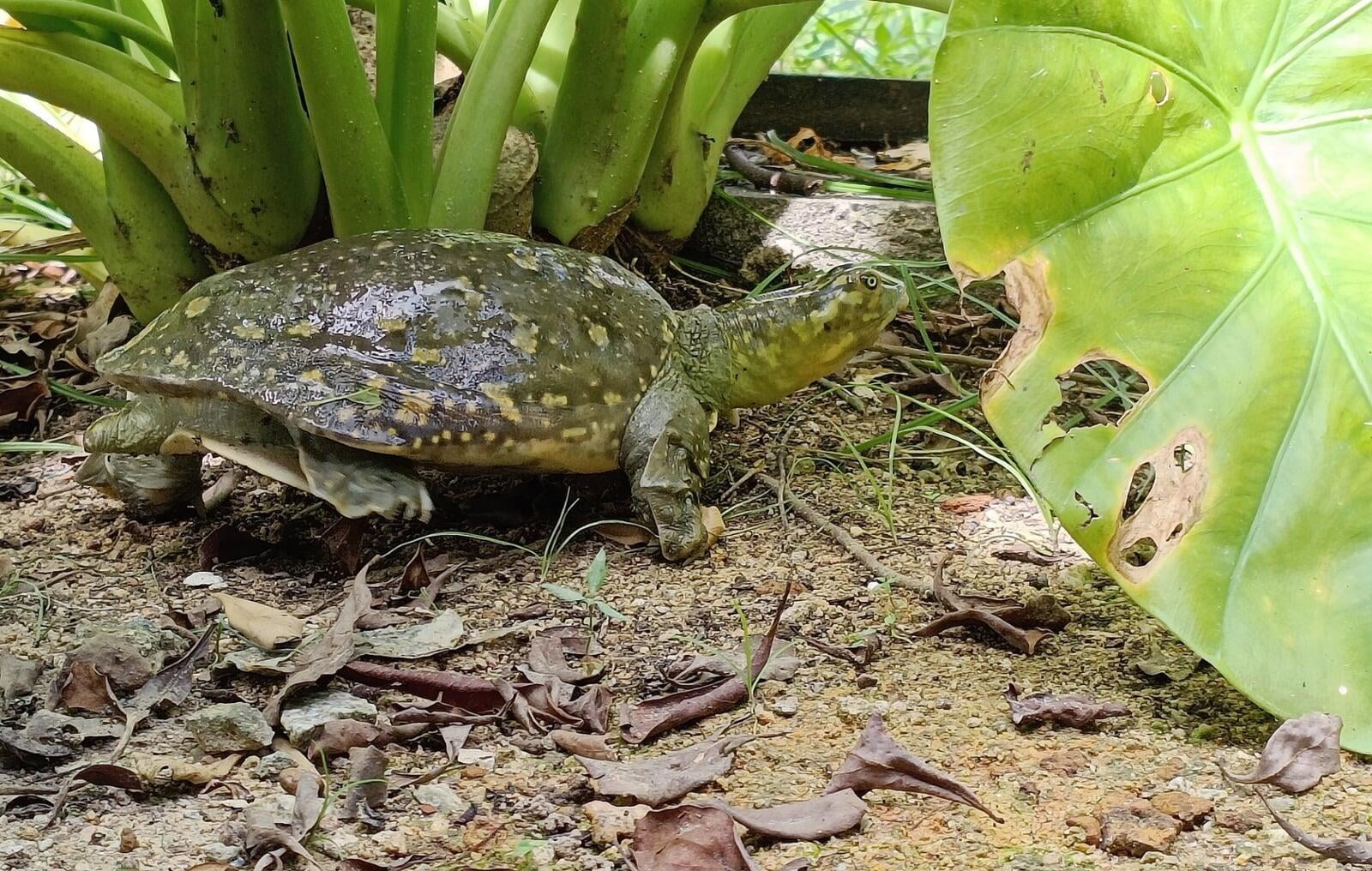
Habitat
The Indian Flapshell Turtle lives in shallow, low flow rivers and often stagnant waters such as rivers, streams, marshes, ponds, and lakes in South Asian countries like India. They play an important role to regulate their local ecosystems by eating various small aquatic animals and insects that rummage in the rivers.
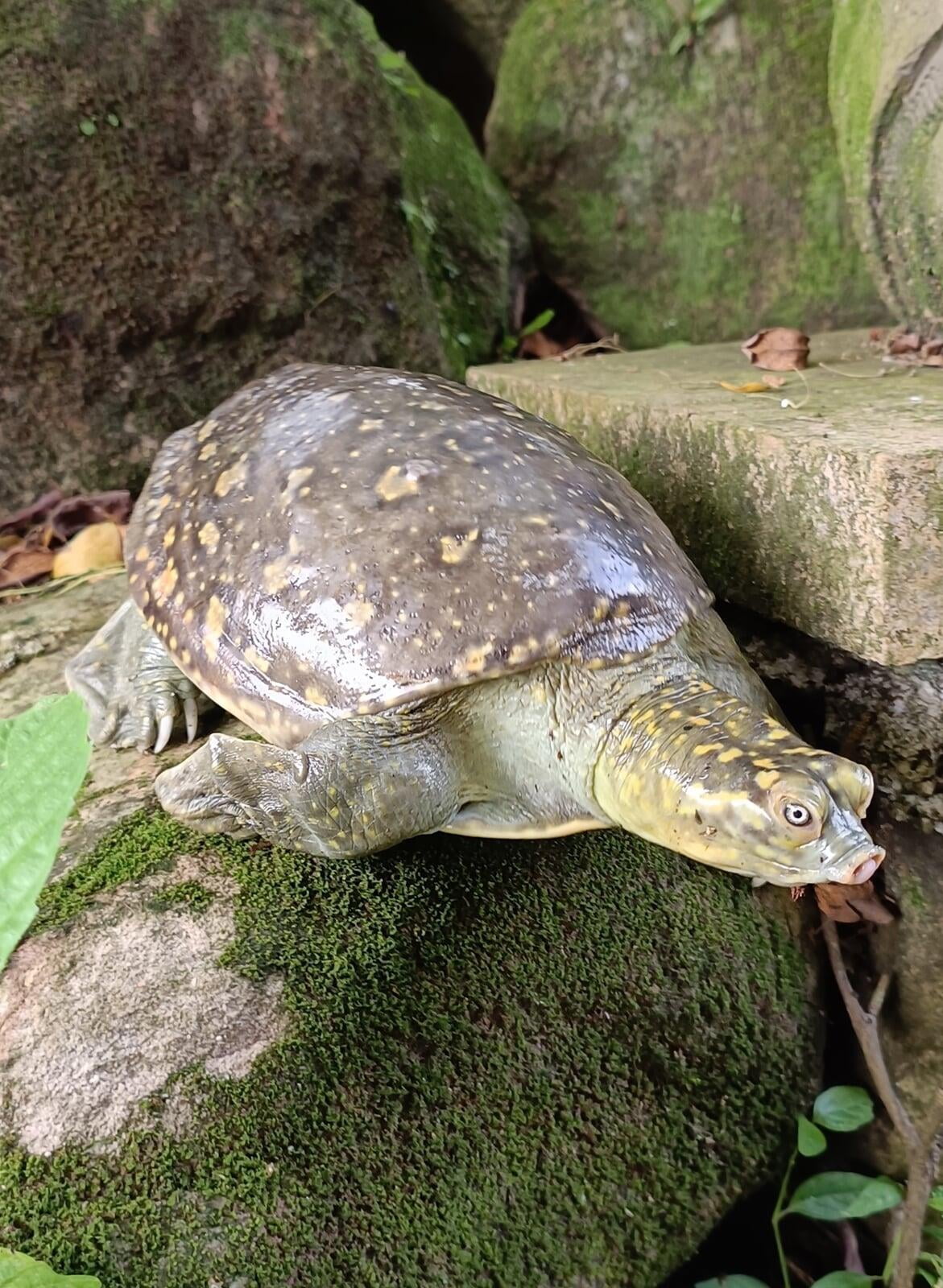
What I do when I'm not in the museum
They are usually solitary animals that will prefer staying in the water, but because of the naturally dryer climate in parts of India where these turtles and indigenous to, some have also been reported to have been able to survive through drought seasons for more than 100 days! To attract females, the male Indian Flapshell Turtle will stroke the female's carapace with its neck and limbs extended, something like a "cuddle" position, and the female is receptive to the male's courtship, the pair will bob their heads as if nodding and agreeing to their union.
| Weight Up to 5kg | Lifespan Up to 30 years |
| Size Up to 30cm | Diet Fish, river grass, and other small aquatic animals |
Malaysian Giant River Turtle
(Orlitia Borneensis)
The Malaysian giant river turtle is the largest freshwater turtle endemic to Southeast Asia. They are a semi- aquatic species which has been heavily exploited for its meat causing rapid diminishment of local populations. They are believed to be omnivorous reptiles who feed on aquatic vegetation as well as carrion.

Habitat
They inhabit the rivers, streams & marshes throughout Cambodia & Vietnam as well as various parts of Laos, Malaysia, Myanmar & Thailand. Their ability to live in both water & on land has made them a highly adaptable species who feeds on a variety of food including fish, carrion, insects as well as aquatic vegetation.
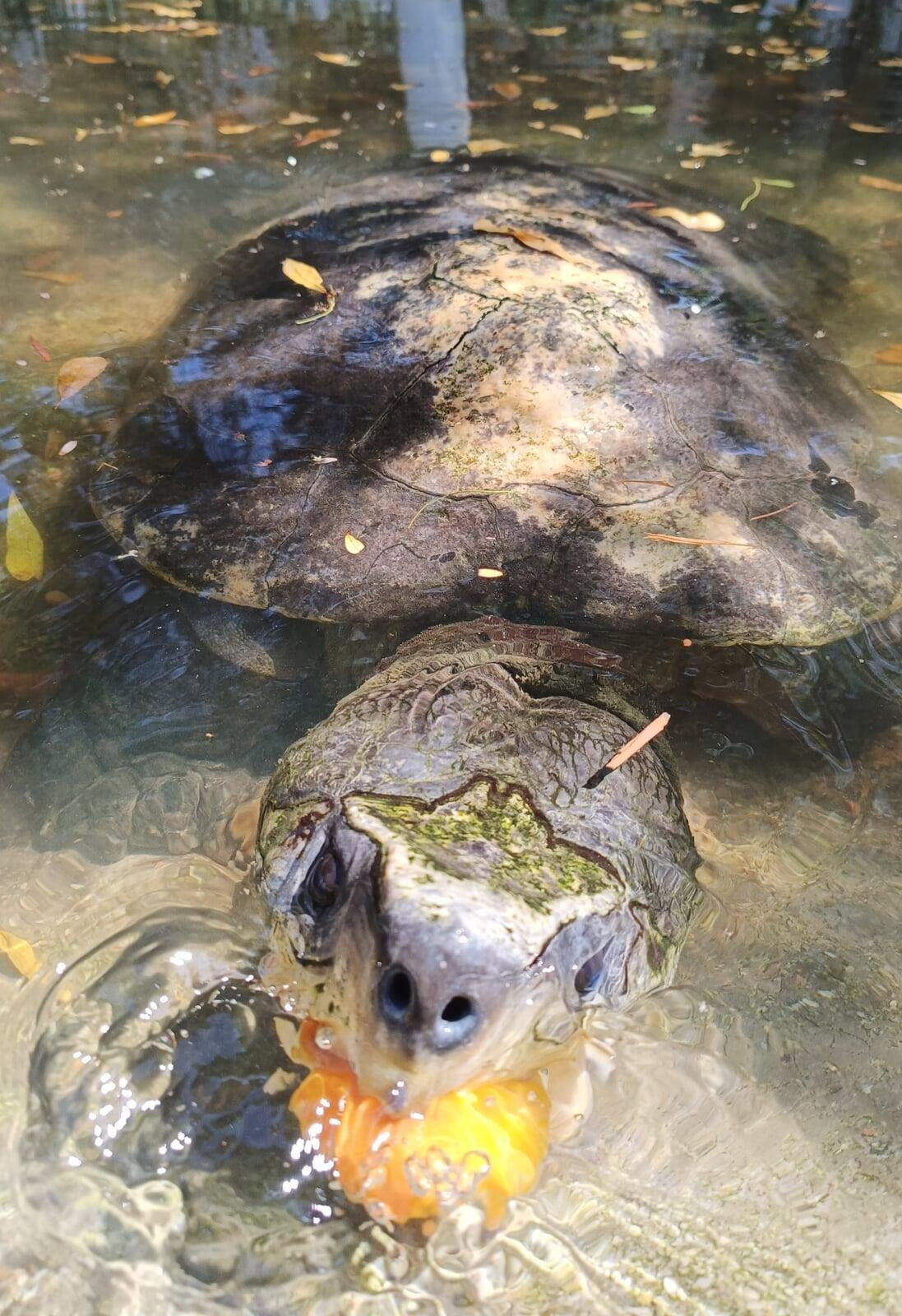
What I do when I'm not in the museum
Asian Giant pond turtles enjoy the privilege of not being limited strictly to water. They have been observed in the wild to regularly come upon shore to bask on logs & stones in their environment. Little has been observed of their mating habits in the wild.
| Weight Up to 60kg | Lifespan Up to 40 years |
| Size Up to 50cm | Diet Fish, and river grass |
Giant Asian Pond Turtle
(Heosemys grandis)
Inhabiting rivers, streams & marshes throughout Southeast Asia, the Giant Asian pond turtle has a predominantly brown to black coloration highlighted by pale yellow streaks which run along the centre of its large carapace. One of the largest semi-aquatic Asian turtles, these reptiles have muscular strong limbs & webbed toes which adapt it very well to both swimming as well as traversal on land.
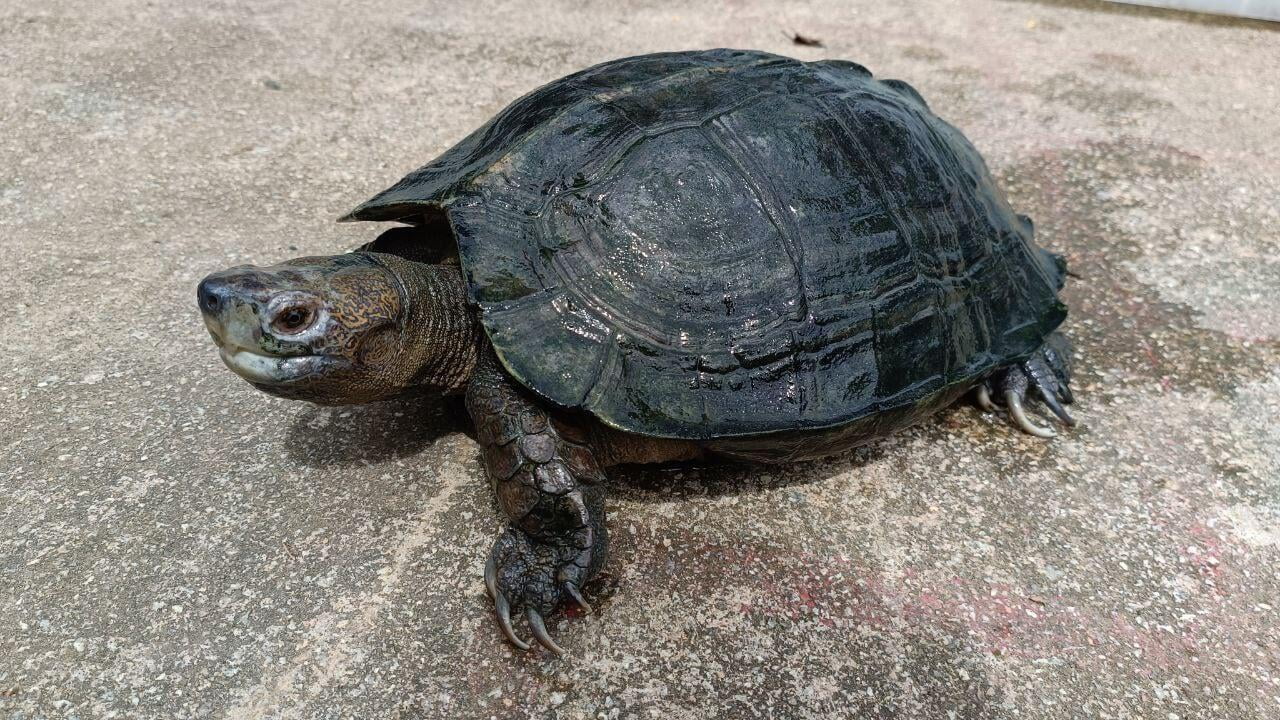
Habitat
They inhabit the rivers, streams & marshes throughout Cambodia & Vietnam as well as various parts of Laos, Malaysia, Myanmar & Thailand. Their ability to live in both water & on land has made them a highly adaptable species who feeds on a variety of food including fish, carrion, insects as well as aquatic vegetation.
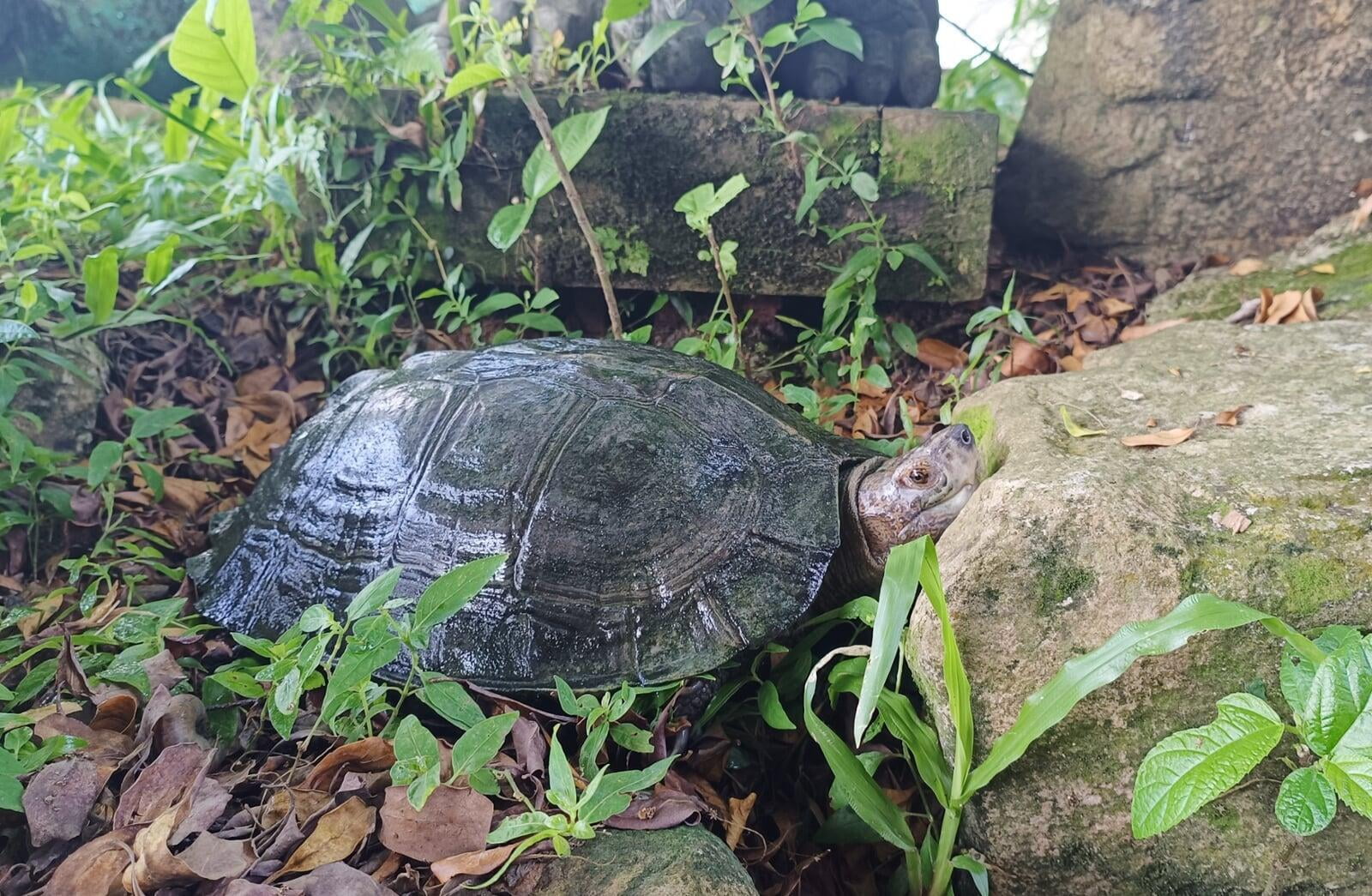
What I do when I'm not in the museum
Asian Giant pond turtles enjoy the privilege of not being limited strictly to water. They have been observed in the wild to regularly come upon shore to bask on logs & stones in their environment. Little has been observed of their mating habits in the wild.
| Weight Up to 20kg | Lifespan Up to 20 years |
| Size Up to 40cm | Diet Fish, river grass, and other small aquatic animals |
False Map Turtle
(Graptemys Pseudogeographica)
The False Map Turtle has distinct L-shaped lines on the top of its head, just behind its eyes. Endemic to USA, the turtle is a common pet species and can also be commonly found in the central states along the Missouri and Mississippi River systems. This unique turtle is also sometimes called the Sawback Turtle because of the jagged row of low spins that can be found near its rear that resembles a saw.
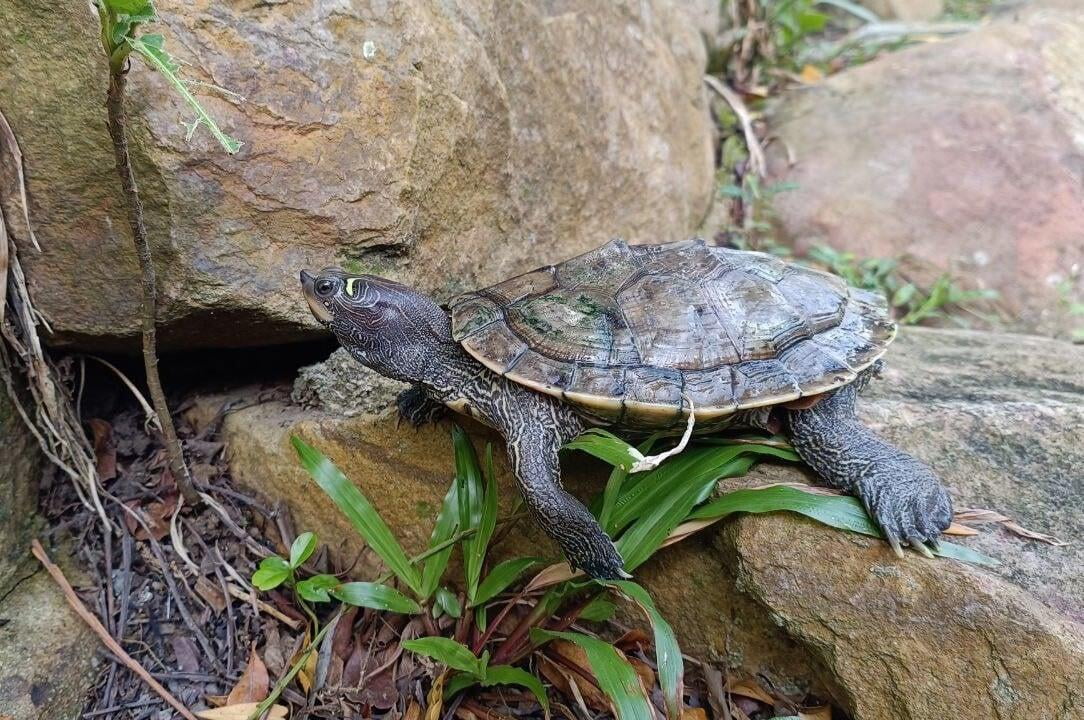
Habitat
The False Map Turtle can be found in states such as Ohio, Indiana, Illinois, Wisconsin, all the way to East Texas, and many more along the Missouri and Mississippi River systems. the take advantage of the large bodies of freshwater for food, as well as suitable breeding spots.
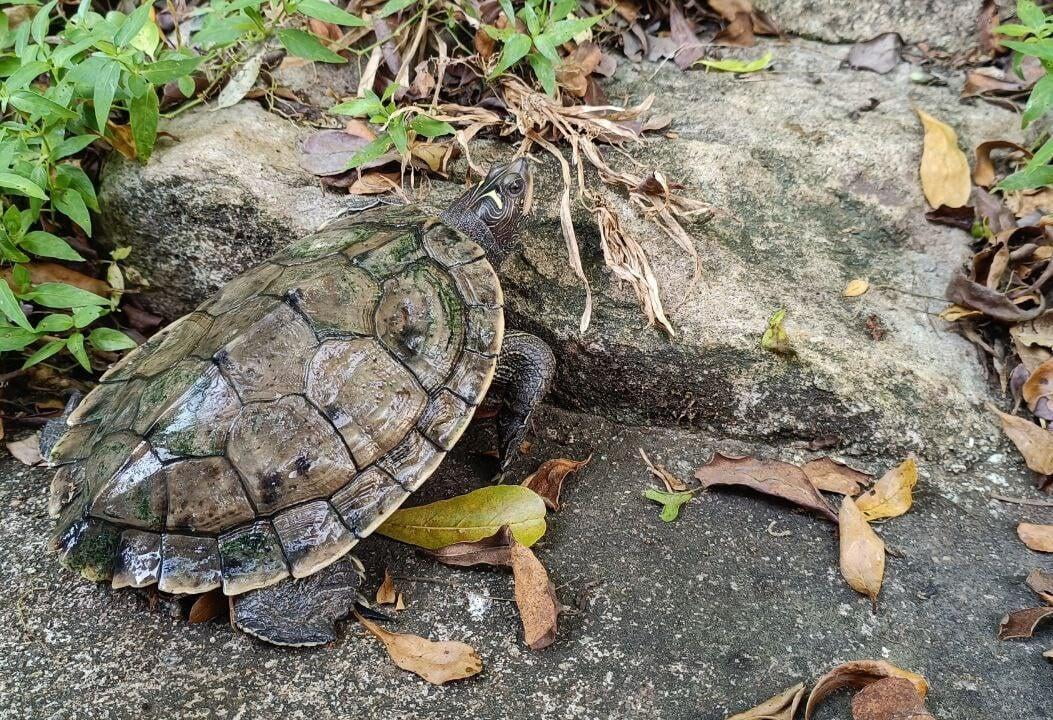
What I do when I'm not in the museum
A semi aquatic turtle which enjoys basking on logs & rocks in the heat of the sun, they have been observed to be a very social and communal species pile on top of each other as they soak in the beneficial rays of sunlight which aids in their digestion as well as regulates their temperature. They also make use of their numbers and more pairs of eyes to predator-watch to increase their chances of survival.
| Weight Up to 2kg | Lifespan 30-35 years |
| Size 15cm to 25cm | Diet Fish, river grass, and other small aquatic animals |
Mississippi Map Turtle
(Graptemys Pseudogeographica Kohni)
Medium sized semi aquatic freshwater turtles, the Mississippi Map Turtle is the subspecies of the False Map Turtle and are most prominent for the linings on their carapace which resemble the contour lines of a map, and a distinct crescent shape moon on the top of their heads. The Mississippi Map turtle are native to North America & widely spotted in the Mississippi River. Another distinguishing feature is their keeled, serrated carapace which smoothens out as the turtle ages.
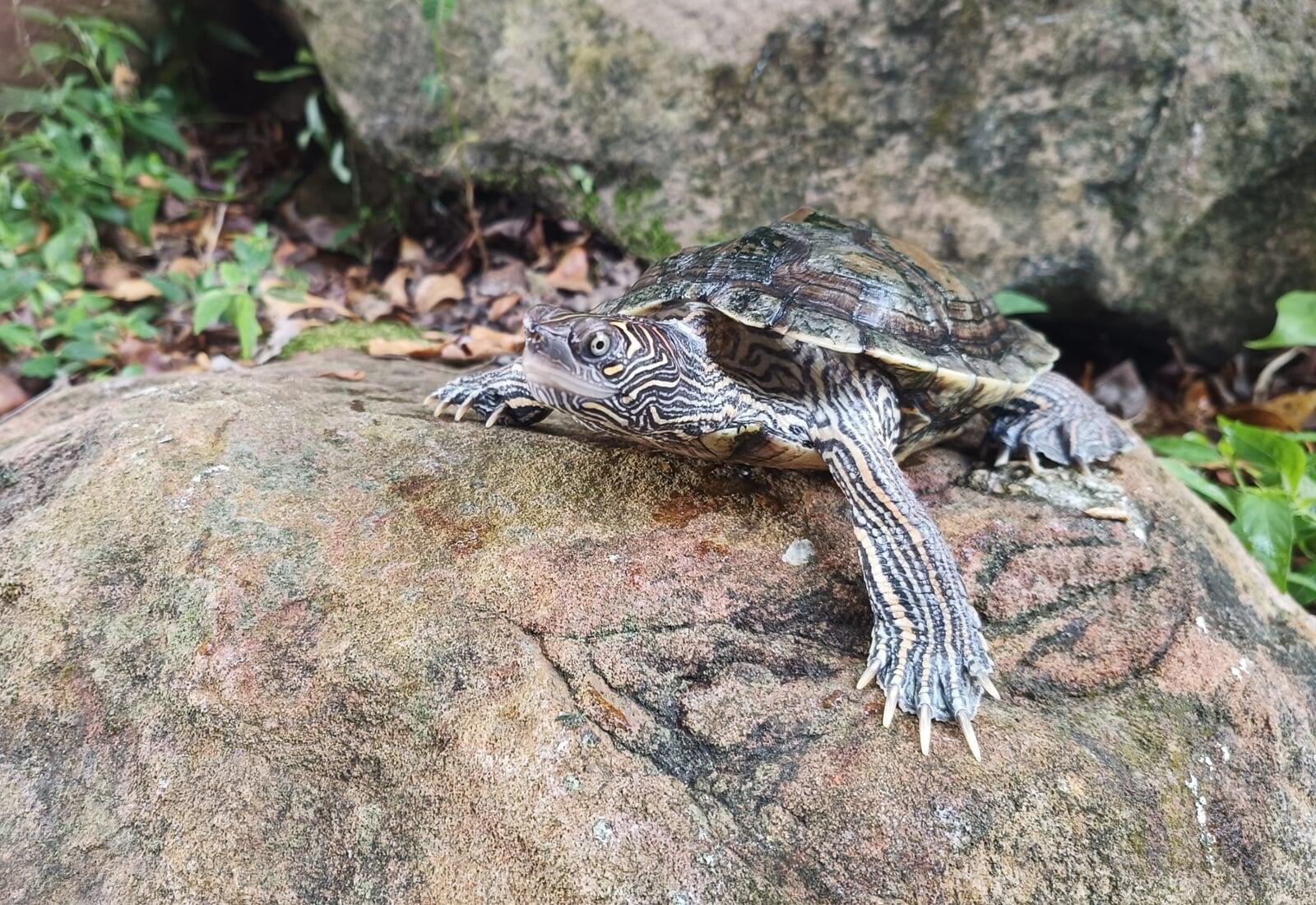
Habitat
They are largely distributed along the Mississippi River Valley ranging from Southwest Iowa & Central Illinois to the Gulf of Mexico. These turtles prefer water locales lush with aquatic vegetation & low currents.
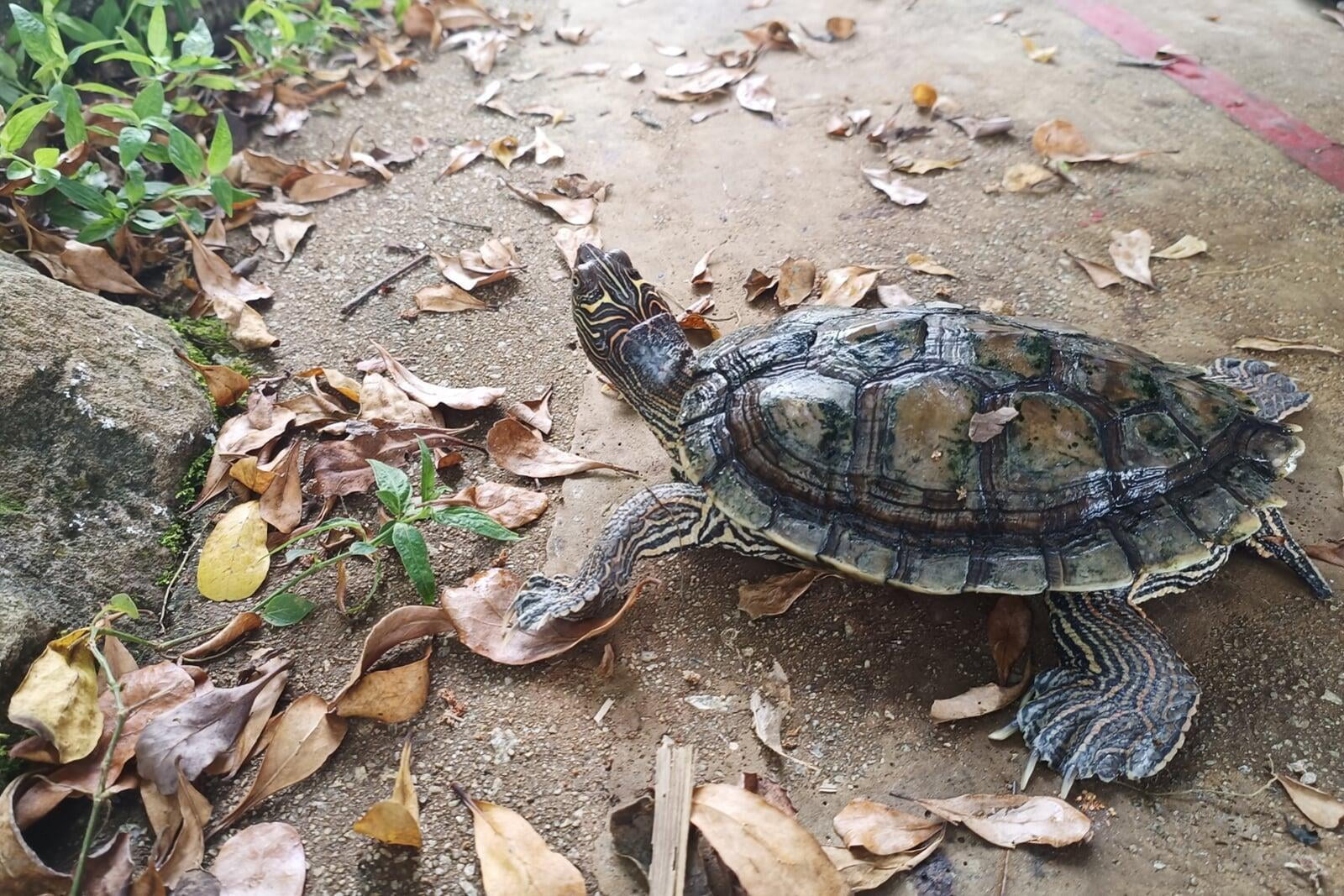
What I do when I'm not in the museum
These turtles are skittish & shy, who will bolt at the first sign of danger. In the wilderness, they have been observed to bask on rocks & logs, sometimes even piling on each other in a bid to absorb the sun’s rays. They are also very social and communal turtles, just like the False Map Turtle, and will look out for one another. Juveniles are largely carnivorous to supplement their growing needs & protein requirements.
| Weight Up to 2kg | Lifespan Up to 30-35 years |
| Size Up to 25cm | Diet Fish, river grass, and other small aquatic animals |
Chinese Pond Turtle
(Chinemys Reevesii)
The Reeves or Chinese pond turtle have three distinguishing ridges which run down its typically tan to dark brown carapace. Its skin, while usually a murky green coupled with yellowish blemishes & stripes, run along the sides of its face down its neck. They are native to Asia & inhabit lakes, ponds & small streams.
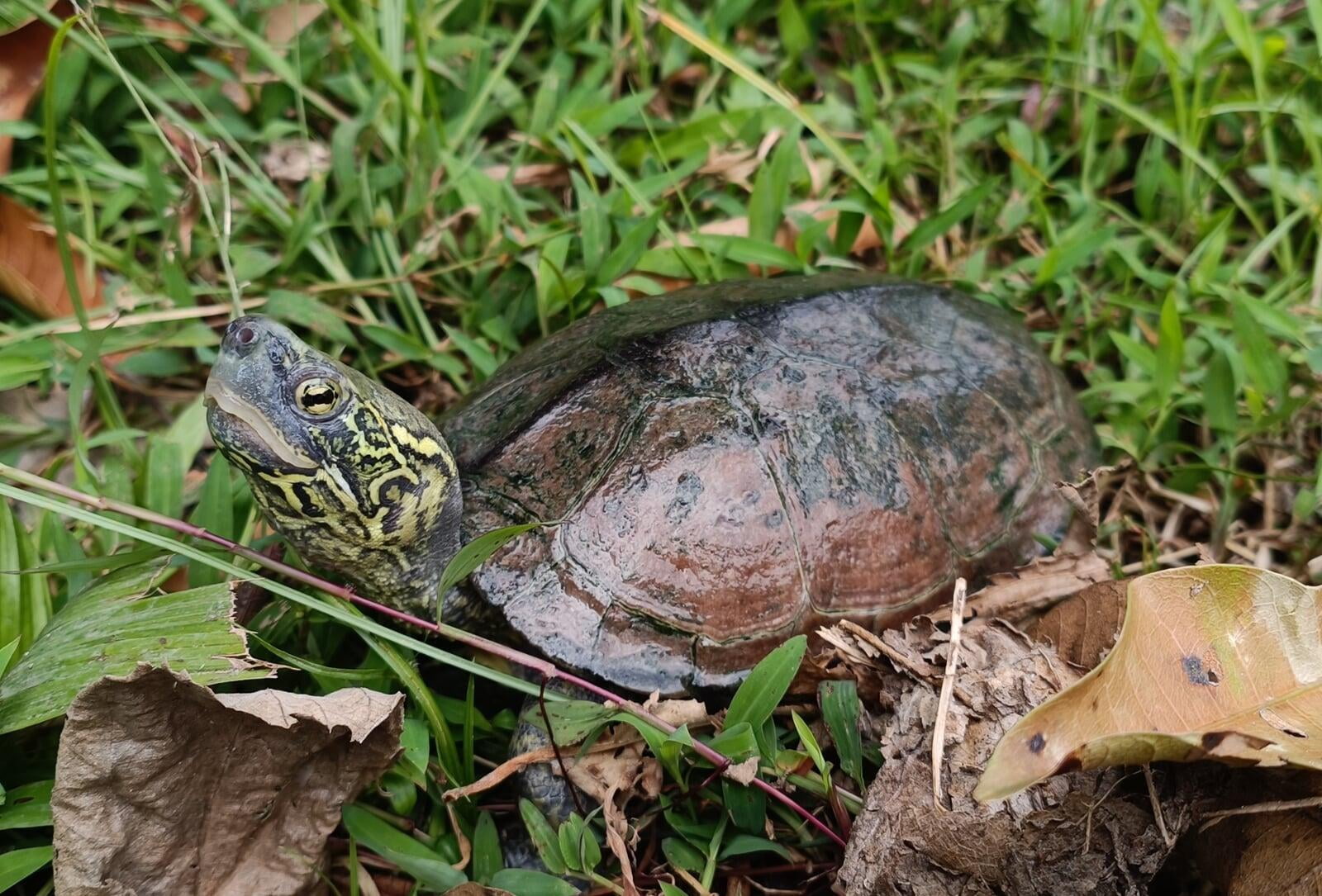
Habitat
Extending across central & eastern China, as well as North & South Korea, Taiwan & Japan, the Reeves turtle predominantly enjoys bodies of water with low currents. These include lakes, ponds & small streams where aquatic vegetation is lush.
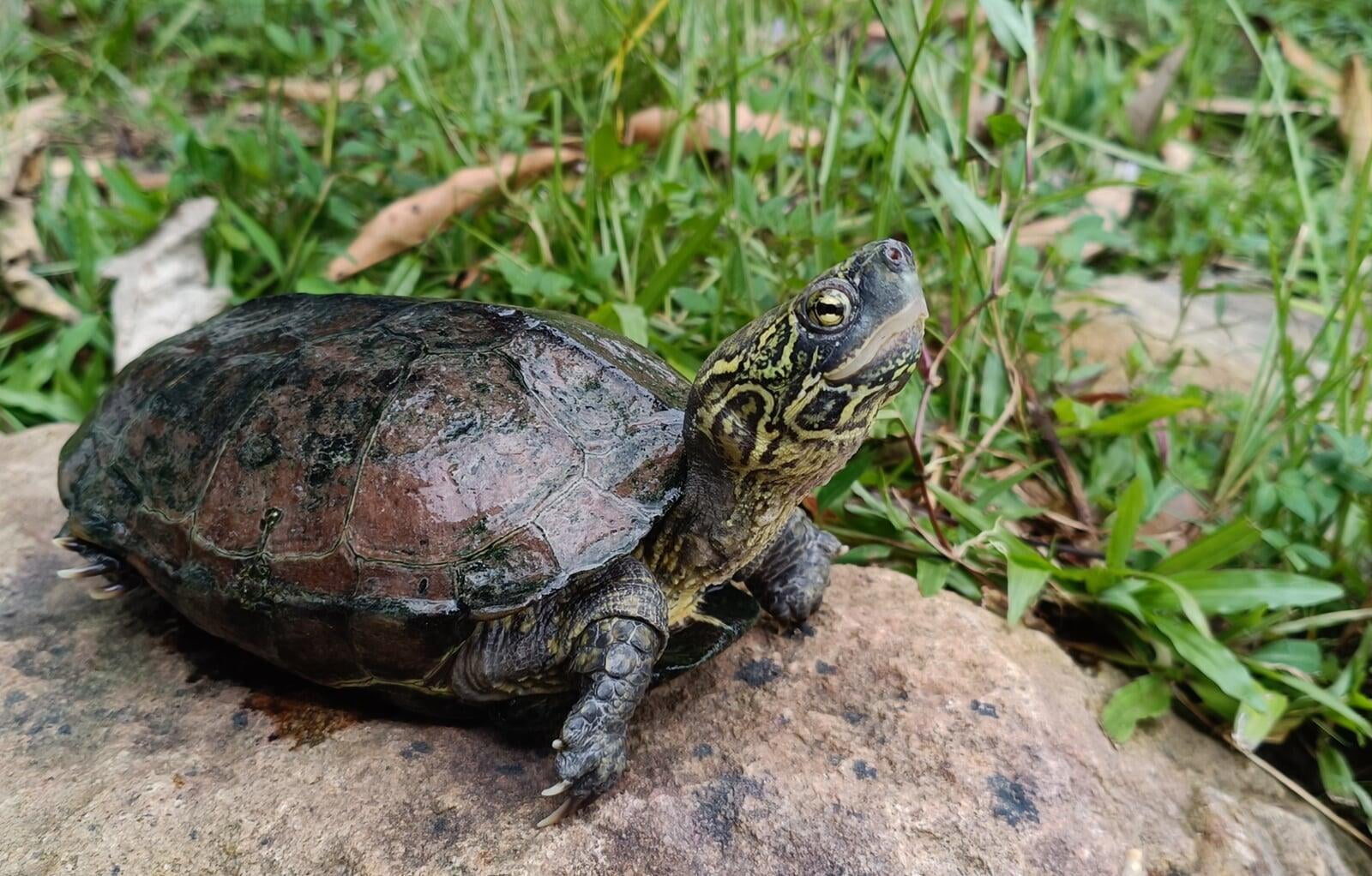
What I do when I'm not in the museum
A semi aquatic turtle which enjoys basking on logs & rocks in the heat of the sun, they have been observed to pile on top of each other as they soak in the beneficial rays of sunlight which aids in their digestion as well as regulates their temperature. In captivity, they are lively & active turtles who are social & recognize their owners.
| Weight Up to 4kg | Lifespan Up to 20 years |
| Size Up to 35cm | Diet Fish, river grass, and other small aquatic animals |
Broad Shell Snake-Necked Turtle
(Chelodina Expansa)
With its serpentine neck & broad oval shaped shell, the Broad Shelled Snake Necked turtle is remarkably unique among its turtle cousins. Endemic to South – Eastern Australia, these turtles can tuck its neck & head under the edge of its carapace as a defensive posture. With a relatively flattened appearance & clawed, webbed feet adapted to swimming in freshwater bodies, these snake necked turtles are ambush predators who will lunge at prey with their long necks, a strategy highly adapted to its deceptive hunting nature.
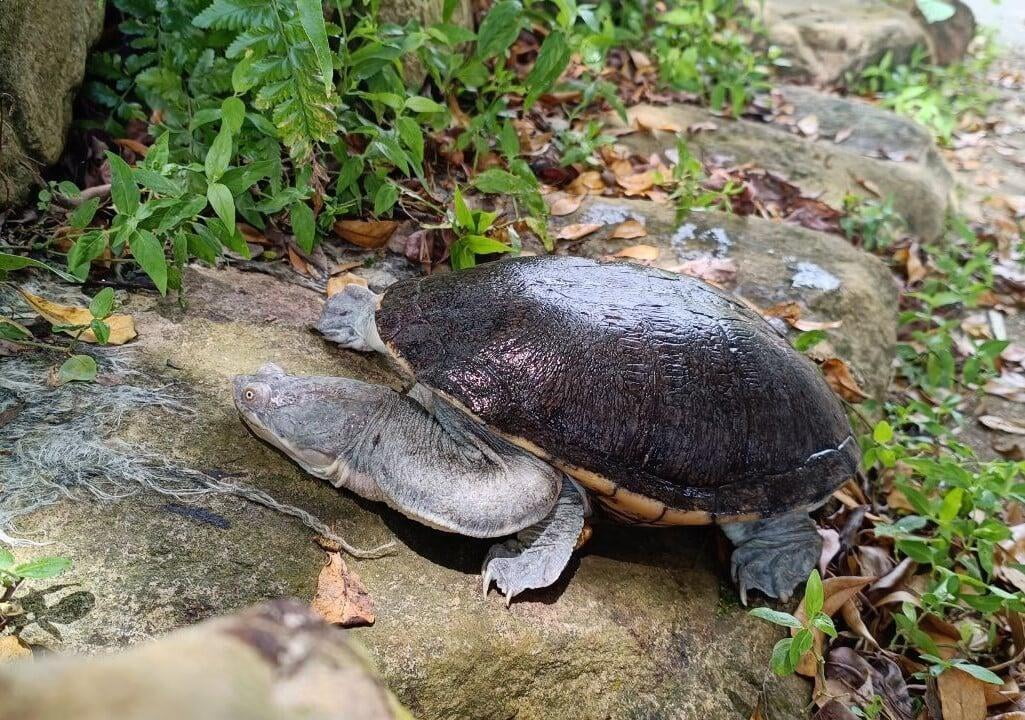
Habitat
They can be found in the rivers in South-Eastern Australia, They spend majority of their lives in water, where fish and other small aquatic animals are plentiful to feed on. They prefer blackwater habitat that might provide them with more camouflage to hunt, but they have been found in various different freshwater habitats.
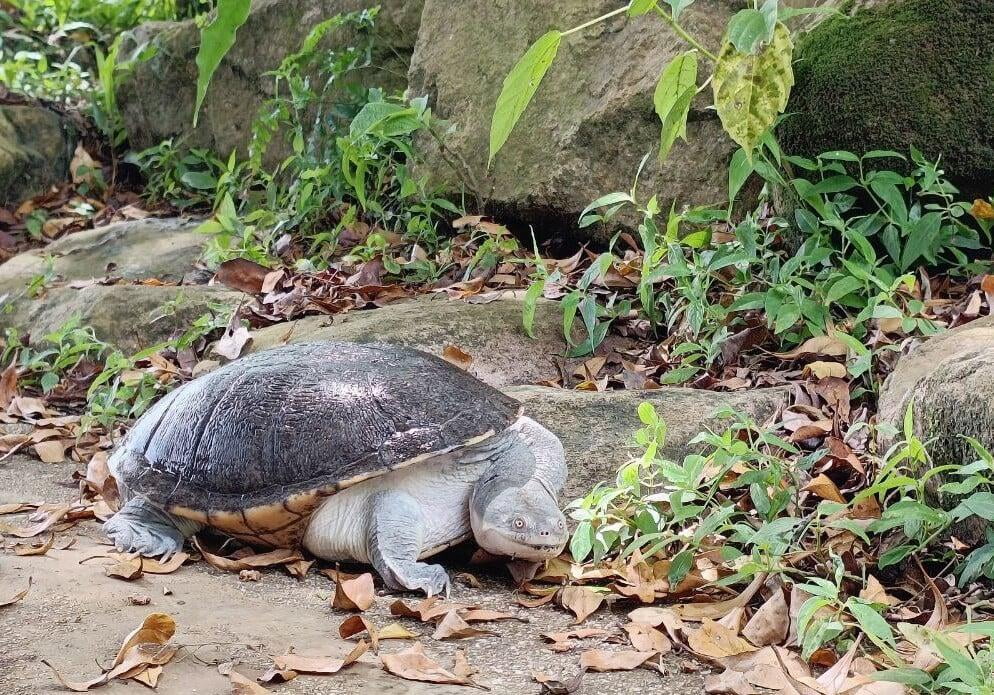
What I do when I'm not in the museum
They are mainly solitary animals, that ambush their prey, and only interact during mating season. Their long necks allow them to stay hidden away from their prey, and lunge out when they come close extremely quickly, making them excellent hunters!
| Weight Up to 5kg | Lifespan Up to 40 years |
| Size Up to 50cm | Diet Fish, and other small aquatic animals |
Spotted Pond Turtle
(Geoclemys Hamiltonii)
The spotted pond turtle is dark, freshwater turtle which is predominantly black in coloration coupled with yellow/white spotty blemishes which are adorned throughout its head & carapace. This contrasting appearance of black on yellow/white makes them incredibly beautiful with hatchlings having brighter coloration which dulls as it ages.
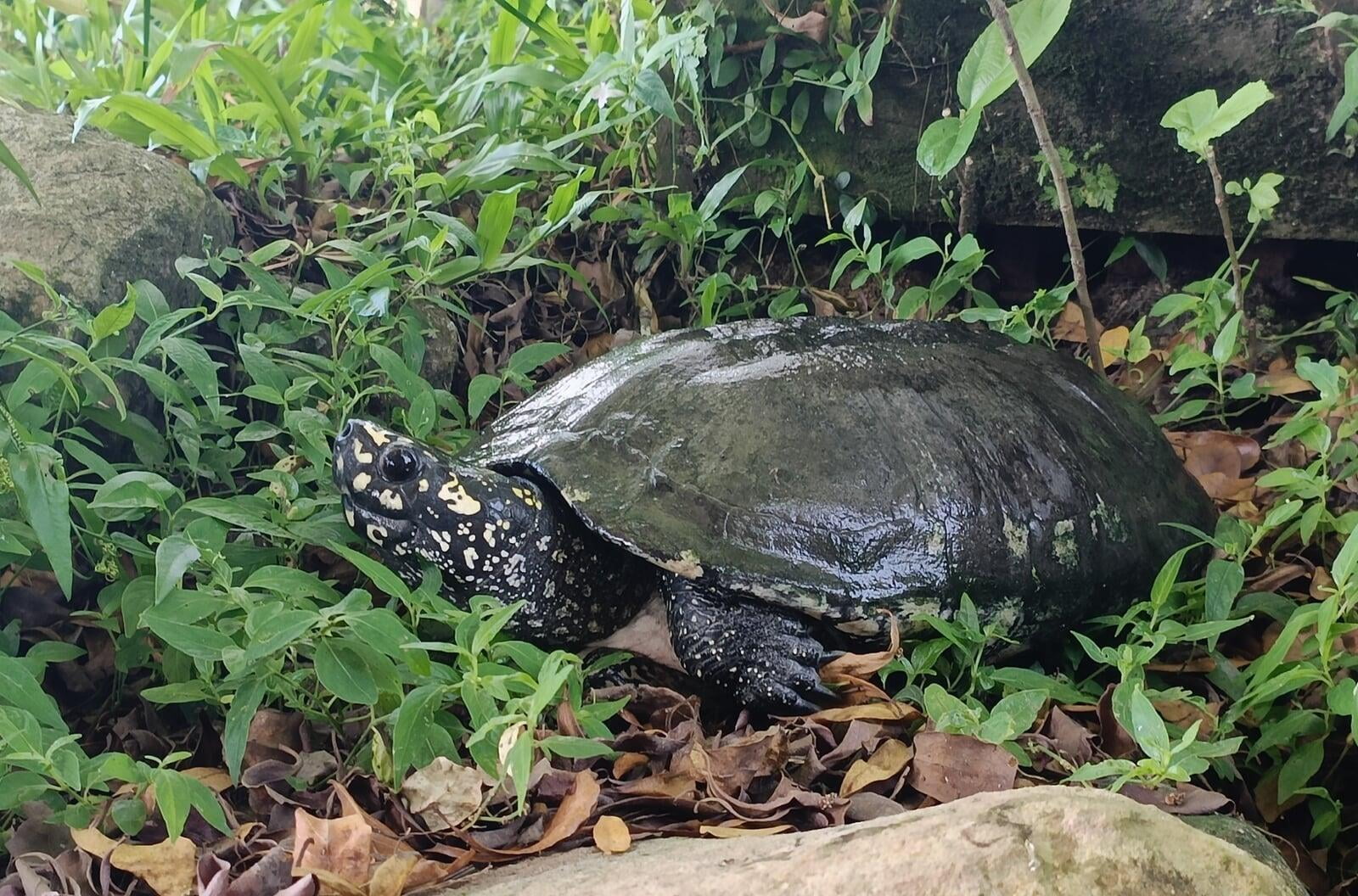
Habitat
They are endemic to the Indus & Ganges river drainage systems of Bangladesh, India, Pakistan & Nepal, primarily residing in in slow moving locales of water such as rivers & lakes lush with aquatic vegetation and small aquatic animals.

What I do when I'm not in the museum
These turtles are shy & passive reptiles that gravitate to aquatic vegetation for the shelter & safety it provides against predators, but get very territorial with others of its kind. While mostly active during dawn & dusk where they will be foraging for snail, fish & plants in their environment, Spotted Pond turtles do bask most primarily on rocks & logs in their environment, alternatively floating on the slow moving waters they inhabit in order to thermally regulate in the heat of the sun.
| Weight Up to 5kg | Lifespan Up to 40 years |
| Size Up to 40cm | Diet Fish, river grass, and other small aquatic animals |
New Guinea Snake-Necked Turtle
(Chelodina Novaeguineae)
Their long neck resembles a snake, which is where they get their name from. New Guinea Snake turtles are found in north-eastern Australia, Indonesia & Papua New Guinea inhabiting freshwater locales where their dark exterior helps them blend with their dark & murky surroundings of the rivers they inhabit.
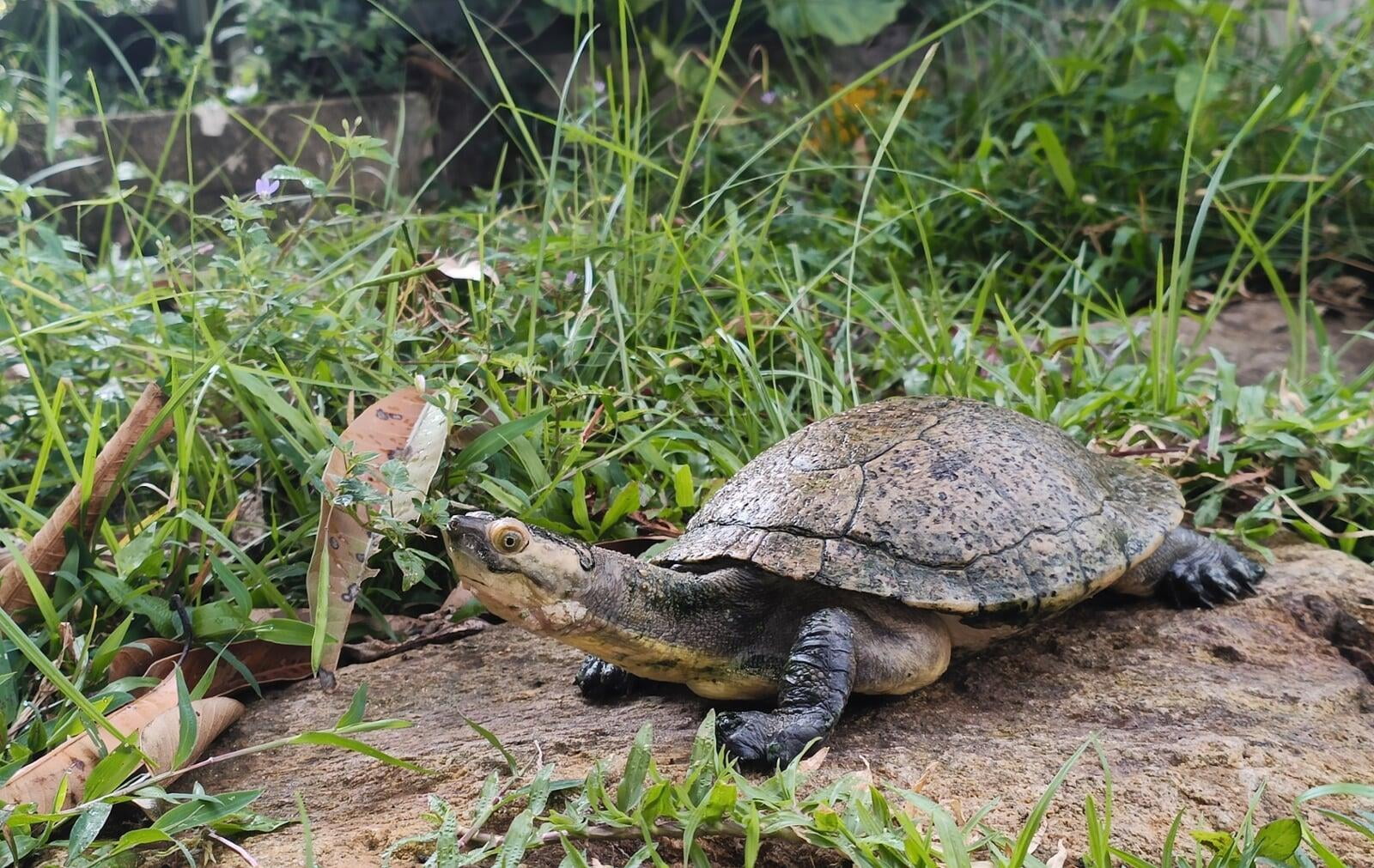
Habitat
They are largely distributed along slow moving bodies of water such as rivers where aquatic vegetation & prey is rife. They are endemic to north-eastern Australia, Indonesia & Papua New Guinea. They stay near the river beds where they can make use of their natural colour and camouflage better to hunt.

What I do when I'm not in the museum
They spend the majority of their time walking on the substrate of their habitat instead of swimming, preferring to ambush their prey from the mud & aquatic vegetation they lay dormant in. When resting, it twists its serpentine long neck to the side for protection instead of withdrawing it into its shell. They aren't known to be the fastest swimmers, but they can still chase their prey and and an extremely fast and painful bite!
| Weight Up to 3kg | Lifespan 15-30 years |
| Size Up to 35cm | Diet Fish, river grass, and other small aquatic animals |
